Products
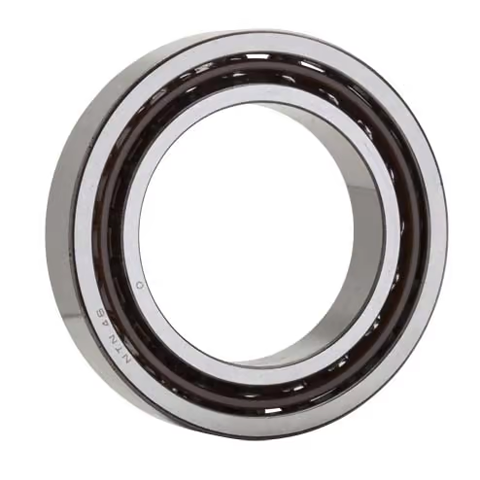
NTN NTN Angular Contact Ball Bearing , 7207
Item # d D B r Static Load Rating Dynamic Load Rating 7207 1.3780 in 35.000 mm 2.8346 in 72.000 mm 0.6693 in 17.000 mm 0.0433 in 1.100 mm 4500 lbf 20100 N 20.10 kN 6700 lbf 29700 N 29.70 kN 1. Design features and characteristics 1.1 Angular contact ball bearing Angular contact ball bearings are non-separable bearings with a defined contact angle in the radial direction relative to the straight line that runs through the point where each ball makes contact with the inner and outer rings (see Fig. 1). Table 1 provides information on contact angles and their designated codes. In addition to radial loads, angular contact ball bearings can accommodate single direction axial loads. Since an axial load is generated from a radial force, these bearings are generally used in pairs. Table 2 shows general angular contact ball bearing characteristics, Table 3 shows information on using duplex (side by side) angular contact ball bearings, and Table 4 shows information on multiple-row angular contact ball bearings. For bearings with a contact angle of 15° and bearing tolerance JIS Class 5 or higher, see special catalog “Precision rolling bearings (CAT. No. 2260/E)”. 1.2 Four-point angular contact ball bearings Four-point angular contact ball bearings have a contact angle of 30° and a split inner ring. As shown in Fig. 2, when the inner and outer rings receive a radial load, the ball contacts the inner and outer rings at four points. This construction enables a single bearing to accommodate axial loads from either direction, and when under a simple axial load or heavy axial load, the bearing relies on two contact points like ordinary bearings. 1.3 Double row angular contact ball bearings The structure of double row angular contact ball bearings is designed by arranging two single row angular contact bearings back-to-back in duplex (DB) to form a single bearing with a contact angle of 25°.These bearings are capable of accommodating radial loads, axial loads in either direction, and have a high capacity for moment loads.As shown in Fig. 4, sealed and shielded type double row angular contact ball bearings are also available. Standard loads vary from those of open type bearings.
$14.61
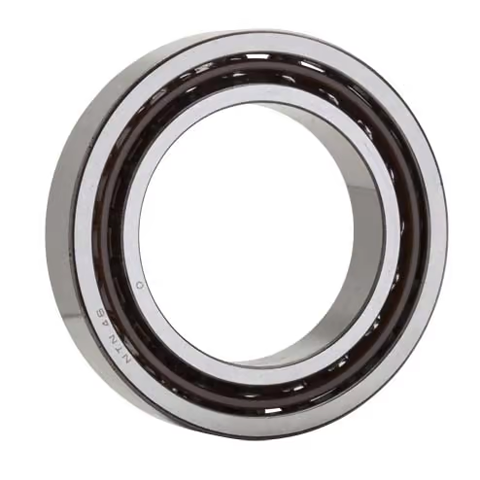
NTN NTN Angular Contact Ball Bearing , 7208
Item # d D B r Static Load Rating Dynamic Load Rating 7208 1.5748 in 40.000 mm 3.1496 in 80.000 mm 0.7087 in 18.000 mm 0.0433 in 1.100 mm 5650 lbf 25100 N 25.10 kN 8000 lbf 35500 N 35.50 kN 1. Design features and characteristics 1.1 Angular contact ball bearing Angular contact ball bearings are non-separable bearings with a defined contact angle in the radial direction relative to the straight line that runs through the point where each ball makes contact with the inner and outer rings (see Fig. 1). Table 1 provides information on contact angles and their designated codes. In addition to radial loads, angular contact ball bearings can accommodate single direction axial loads. Since an axial load is generated from a radial force, these bearings are generally used in pairs. Table 2 shows general angular contact ball bearing characteristics, Table 3 shows information on using duplex (side by side) angular contact ball bearings, and Table 4 shows information on multiple-row angular contact ball bearings. For bearings with a contact angle of 15° and bearing tolerance JIS Class 5 or higher, see special catalog “Precision rolling bearings (CAT. No. 2260/E)”. 1.2 Four-point angular contact ball bearings Four-point angular contact ball bearings have a contact angle of 30° and a split inner ring. As shown in Fig. 2, when the inner and outer rings receive a radial load, the ball contacts the inner and outer rings at four points. This construction enables a single bearing to accommodate axial loads from either direction, and when under a simple axial load or heavy axial load, the bearing relies on two contact points like ordinary bearings. 1.3 Double row angular contact ball bearings The structure of double row angular contact ball bearings is designed by arranging two single row angular contact bearings back-to-back in duplex (DB) to form a single bearing with a contact angle of 25°.These bearings are capable of accommodating radial loads, axial loads in either direction, and have a high capacity for moment loads.As shown in Fig. 4, sealed and shielded type double row angular contact ball bearings are also available. Standard loads vary from those of open type bearings.
$18.19
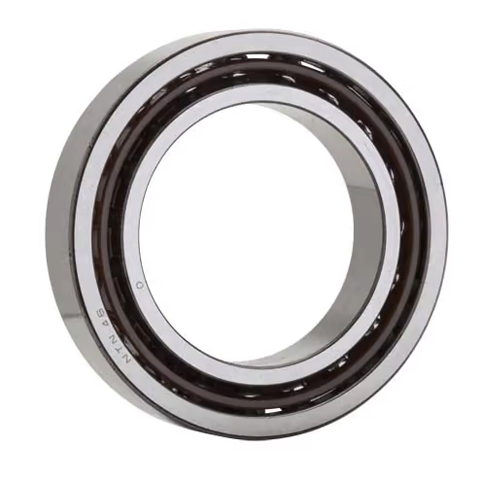
NTN NTN Angular Contact Ball Bearing , 7209
Item # d D B r Static Load Rating Dynamic Load Rating 7209 1.7717 in 45.000 mm 3.3465 in 85.000 mm 0.7480 in 19.000 mm 0.0433 in 1.100 mm 6450 lbf 28700 N 28.70 kN 8900 lbf 39500 N 39.50 kN 1. Design features and characteristics 1.1 Angular contact ball bearing Angular contact ball bearings are non-separable bearings with a defined contact angle in the radial direction relative to the straight line that runs through the point where each ball makes contact with the inner and outer rings (see Fig. 1). Table 1 provides information on contact angles and their designated codes. In addition to radial loads, angular contact ball bearings can accommodate single direction axial loads. Since an axial load is generated from a radial force, these bearings are generally used in pairs. Table 2 shows general angular contact ball bearing characteristics, Table 3 shows information on using duplex (side by side) angular contact ball bearings, and Table 4 shows information on multiple-row angular contact ball bearings. For bearings with a contact angle of 15° and bearing tolerance JIS Class 5 or higher, see special catalog “Precision rolling bearings (CAT. No. 2260/E)”. 1.2 Four-point angular contact ball bearings Four-point angular contact ball bearings have a contact angle of 30° and a split inner ring. As shown in Fig. 2, when the inner and outer rings receive a radial load, the ball contacts the inner and outer rings at four points. This construction enables a single bearing to accommodate axial loads from either direction, and when under a simple axial load or heavy axial load, the bearing relies on two contact points like ordinary bearings. 1.3 Double row angular contact ball bearings The structure of double row angular contact ball bearings is designed by arranging two single row angular contact bearings back-to-back in duplex (DB) to form a single bearing with a contact angle of 25°.These bearings are capable of accommodating radial loads, axial loads in either direction, and have a high capacity for moment loads.As shown in Fig. 4, sealed and shielded type double row angular contact ball bearings are also available. Standard loads vary from those of open type bearings.
$18.70
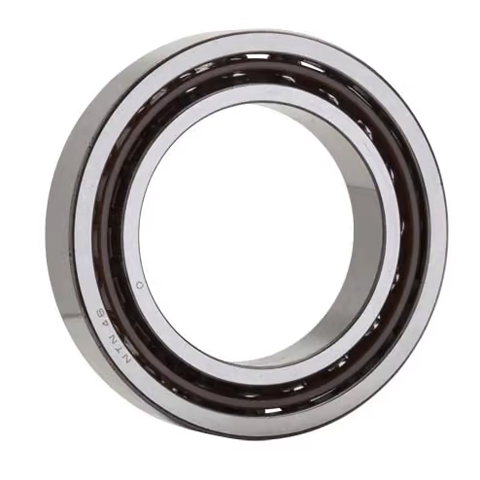
NTN NTN Angular Contact Ball Bearing , 7210
Item # d D B r Static Load Rating Dynamic Load Rating 7210 1.9685 in 50.000 mm 3.5433 in 90.000 mm 0.7874 in 20.000 mm 0.0433 in 1.100 mm 7100 lbf 31500 N 31.50 kN 9350 lbf 41500 N 41.50 kN 1. Design features and characteristics 1.1 Angular contact ball bearing Angular contact ball bearings are non-separable bearings with a defined contact angle in the radial direction relative to the straight line that runs through the point where each ball makes contact with the inner and outer rings (see Fig. 1). Table 1 provides information on contact angles and their designated codes. In addition to radial loads, angular contact ball bearings can accommodate single direction axial loads. Since an axial load is generated from a radial force, these bearings are generally used in pairs. Table 2 shows general angular contact ball bearing characteristics, Table 3 shows information on using duplex (side by side) angular contact ball bearings, and Table 4 shows information on multiple-row angular contact ball bearings. For bearings with a contact angle of 15° and bearing tolerance JIS Class 5 or higher, see special catalog “Precision rolling bearings (CAT. No. 2260/E)”. 1.2 Four-point angular contact ball bearings Four-point angular contact ball bearings have a contact angle of 30° and a split inner ring. As shown in Fig. 2, when the inner and outer rings receive a radial load, the ball contacts the inner and outer rings at four points. This construction enables a single bearing to accommodate axial loads from either direction, and when under a simple axial load or heavy axial load, the bearing relies on two contact points like ordinary bearings. 1.3 Double row angular contact ball bearings The structure of double row angular contact ball bearings is designed by arranging two single row angular contact bearings back-to-back in duplex (DB) to form a single bearing with a contact angle of 25°.These bearings are capable of accommodating radial loads, axial loads in either direction, and have a high capacity for moment loads.As shown in Fig. 4, sealed and shielded type double row angular contact ball bearings are also available. Standard loads vary from those of open type bearings.
$22.32
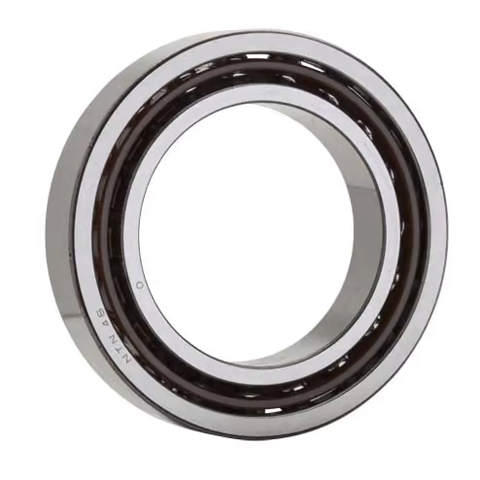
NTN NTN Angular Contact Ball Bearing , 7211
Item # d D B r Static Load Rating Dynamic Load Rating 7211 2.1654 in 55.000 mm 3.9370 in 100.000 mm 0.8268 in 21.000 mm 0.0591 in 1.500 mm 8900 lbf 39500 N 39.50 kN 11500 lbf 51000 N 51.00 kN 1. Design features and characteristics 1.1 Angular contact ball bearing Angular contact ball bearings are non-separable bearings with a defined contact angle in the radial direction relative to the straight line that runs through the point where each ball makes contact with the inner and outer rings (see Fig. 1). Table 1 provides information on contact angles and their designated codes. In addition to radial loads, angular contact ball bearings can accommodate single direction axial loads. Since an axial load is generated from a radial force, these bearings are generally used in pairs. Table 2 shows general angular contact ball bearing characteristics, Table 3 shows information on using duplex (side by side) angular contact ball bearings, and Table 4 shows information on multiple-row angular contact ball bearings. For bearings with a contact angle of 15° and bearing tolerance JIS Class 5 or higher, see special catalog “Precision rolling bearings (CAT. No. 2260/E)”. 1.2 Four-point angular contact ball bearings Four-point angular contact ball bearings have a contact angle of 30° and a split inner ring. As shown in Fig. 2, when the inner and outer rings receive a radial load, the ball contacts the inner and outer rings at four points. This construction enables a single bearing to accommodate axial loads from either direction, and when under a simple axial load or heavy axial load, the bearing relies on two contact points like ordinary bearings. 1.3 Double row angular contact ball bearings The structure of double row angular contact ball bearings is designed by arranging two single row angular contact bearings back-to-back in duplex (DB) to form a single bearing with a contact angle of 25°.These bearings are capable of accommodating radial loads, axial loads in either direction, and have a high capacity for moment loads.As shown in Fig. 4, sealed and shielded type double row angular contact ball bearings are also available. Standard loads vary from those of open type bearings.
$25.18
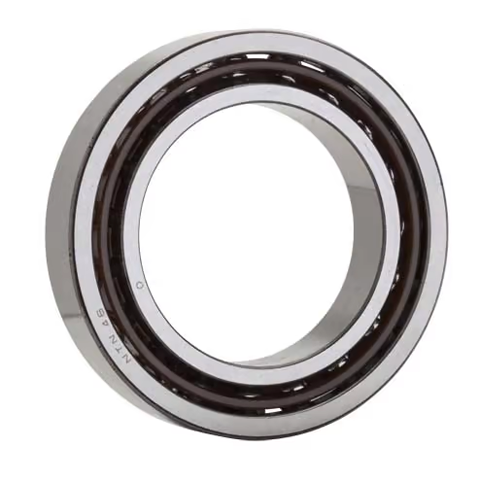
NTN NTN Angular Contact Ball Bearing , 7212
Item # d D B r Static Load Rating Dynamic Load Rating 7212 2.3622 in 60.000 mm 4.3307 in 110.000 mm 0.8661 in 22.000 mm 0.0591 in 1.500 mm 11000 lbf 49000 N 49.00 kN 13800 lbf 61500 N 61.50 kN 1. Design features and characteristics 1.1 Angular contact ball bearing Angular contact ball bearings are non-separable bearings with a defined contact angle in the radial direction relative to the straight line that runs through the point where each ball makes contact with the inner and outer rings (see Fig. 1). Table 1 provides information on contact angles and their designated codes. In addition to radial loads, angular contact ball bearings can accommodate single direction axial loads. Since an axial load is generated from a radial force, these bearings are generally used in pairs. Table 2 shows general angular contact ball bearing characteristics, Table 3 shows information on using duplex (side by side) angular contact ball bearings, and Table 4 shows information on multiple-row angular contact ball bearings. For bearings with a contact angle of 15° and bearing tolerance JIS Class 5 or higher, see special catalog “Precision rolling bearings (CAT. No. 2260/E)”. 1.2 Four-point angular contact ball bearings Four-point angular contact ball bearings have a contact angle of 30° and a split inner ring. As shown in Fig. 2, when the inner and outer rings receive a radial load, the ball contacts the inner and outer rings at four points. This construction enables a single bearing to accommodate axial loads from either direction, and when under a simple axial load or heavy axial load, the bearing relies on two contact points like ordinary bearings. 1.3 Double row angular contact ball bearings The structure of double row angular contact ball bearings is designed by arranging two single row angular contact bearings back-to-back in duplex (DB) to form a single bearing with a contact angle of 25°.These bearings are capable of accommodating radial loads, axial loads in either direction, and have a high capacity for moment loads.As shown in Fig. 4, sealed and shielded type double row angular contact ball bearings are also available. Standard loads vary from those of open type bearings.
$30.30
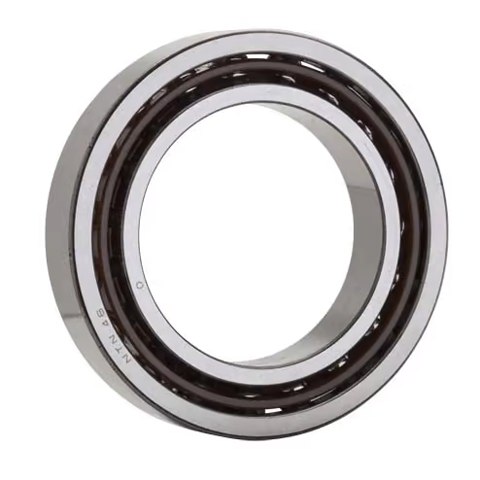
NTN NTN Angular Contact Ball Bearing , 7213
Item # d D B r Static Load Rating Dynamic Load Rating 7213 2.5591 in 65.000 mm 4.7244 in 120.000 mm 0.9055 in 23.000 mm 0.0591 in 1.500 mm 13000 lbf 58000 N 58.00 kN 15800 lbf 70500 N 70.50 kN 1. Design features and characteristics 1.1 Angular contact ball bearing Angular contact ball bearings are non-separable bearings with a defined contact angle in the radial direction relative to the straight line that runs through the point where each ball makes contact with the inner and outer rings (see Fig. 1). Table 1 provides information on contact angles and their designated codes. In addition to radial loads, angular contact ball bearings can accommodate single direction axial loads. Since an axial load is generated from a radial force, these bearings are generally used in pairs. Table 2 shows general angular contact ball bearing characteristics, Table 3 shows information on using duplex (side by side) angular contact ball bearings, and Table 4 shows information on multiple-row angular contact ball bearings. For bearings with a contact angle of 15° and bearing tolerance JIS Class 5 or higher, see special catalog “Precision rolling bearings (CAT. No. 2260/E)”. 1.2 Four-point angular contact ball bearings Four-point angular contact ball bearings have a contact angle of 30° and a split inner ring. As shown in Fig. 2, when the inner and outer rings receive a radial load, the ball contacts the inner and outer rings at four points. This construction enables a single bearing to accommodate axial loads from either direction, and when under a simple axial load or heavy axial load, the bearing relies on two contact points like ordinary bearings. 1.3 Double row angular contact ball bearings The structure of double row angular contact ball bearings is designed by arranging two single row angular contact bearings back-to-back in duplex (DB) to form a single bearing with a contact angle of 25°.These bearings are capable of accommodating radial loads, axial loads in either direction, and have a high capacity for moment loads.As shown in Fig. 4, sealed and shielded type double row angular contact ball bearings are also available. Standard loads vary from those of open type bearings.
$41.84
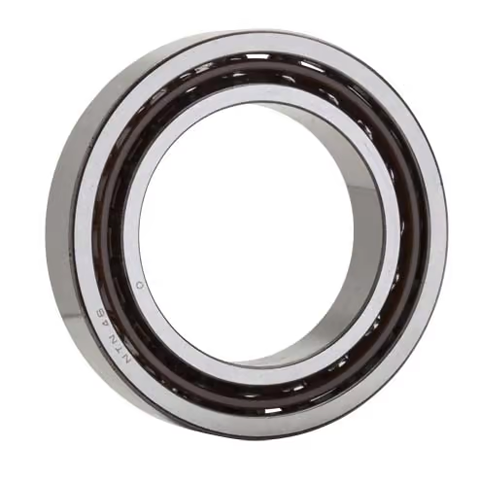
NTN NTN Angular Contact Ball Bearing , 7214
Item # d D B r Static Load Rating Dynamic Load Rating 7214 2.7559 in 70.000 mm 4.9213 in 125.000 mm 0.9449 in 24.000 mm 0.0591 in 1.500 mm 14300 lbf 63500 N 63.50 kN 17200 lbf 76500 N 76.50 kN 1. Design features and characteristics 1.1 Angular contact ball bearing Angular contact ball bearings are non-separable bearings with a defined contact angle in the radial direction relative to the straight line that runs through the point where each ball makes contact with the inner and outer rings (see Fig. 1). Table 1 provides information on contact angles and their designated codes. In addition to radial loads, angular contact ball bearings can accommodate single direction axial loads. Since an axial load is generated from a radial force, these bearings are generally used in pairs. Table 2 shows general angular contact ball bearing characteristics, Table 3 shows information on using duplex (side by side) angular contact ball bearings, and Table 4 shows information on multiple-row angular contact ball bearings. For bearings with a contact angle of 15° and bearing tolerance JIS Class 5 or higher, see special catalog “Precision rolling bearings (CAT. No. 2260/E)”. 1.2 Four-point angular contact ball bearings Four-point angular contact ball bearings have a contact angle of 30° and a split inner ring. As shown in Fig. 2, when the inner and outer rings receive a radial load, the ball contacts the inner and outer rings at four points. This construction enables a single bearing to accommodate axial loads from either direction, and when under a simple axial load or heavy axial load, the bearing relies on two contact points like ordinary bearings. 1.3 Double row angular contact ball bearings The structure of double row angular contact ball bearings is designed by arranging two single row angular contact bearings back-to-back in duplex (DB) to form a single bearing with a contact angle of 25°.These bearings are capable of accommodating radial loads, axial loads in either direction, and have a high capacity for moment loads.As shown in Fig. 4, sealed and shielded type double row angular contact ball bearings are also available. Standard loads vary from those of open type bearings.
$49.53
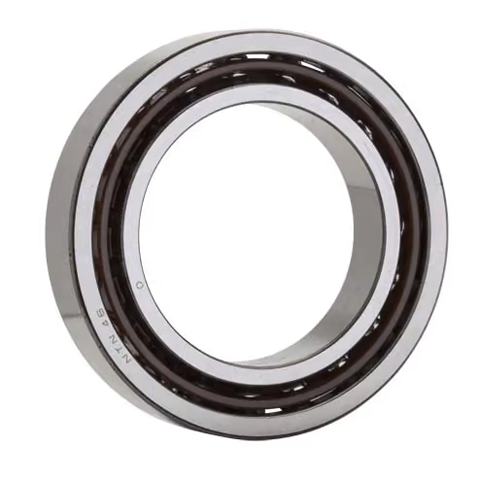
NTN NTN Angular Contact Ball Bearing , 7215
Item # d D B r Static Load Rating Dynamic Load Rating 7215 2.9528 in 75.000 mm 5.1181 in 130.000 mm 0.9843 in 25.000 mm 0.0591 in 1.500 mm 15400 lbf 68500 N 68.50 kN 17800 lbf 79000 N 79.00 kN 1. Design features and characteristics 1.1 Angular contact ball bearing Angular contact ball bearings are non-separable bearings with a defined contact angle in the radial direction relative to the straight line that runs through the point where each ball makes contact with the inner and outer rings (see Fig. 1). Table 1 provides information on contact angles and their designated codes. In addition to radial loads, angular contact ball bearings can accommodate single direction axial loads. Since an axial load is generated from a radial force, these bearings are generally used in pairs. Table 2 shows general angular contact ball bearing characteristics, Table 3 shows information on using duplex (side by side) angular contact ball bearings, and Table 4 shows information on multiple-row angular contact ball bearings. For bearings with a contact angle of 15° and bearing tolerance JIS Class 5 or higher, see special catalog “Precision rolling bearings (CAT. No. 2260/E)”. 1.2 Four-point angular contact ball bearings Four-point angular contact ball bearings have a contact angle of 30° and a split inner ring. As shown in Fig. 2, when the inner and outer rings receive a radial load, the ball contacts the inner and outer rings at four points. This construction enables a single bearing to accommodate axial loads from either direction, and when under a simple axial load or heavy axial load, the bearing relies on two contact points like ordinary bearings. 1.3 Double row angular contact ball bearings The structure of double row angular contact ball bearings is designed by arranging two single row angular contact bearings back-to-back in duplex (DB) to form a single bearing with a contact angle of 25°.These bearings are capable of accommodating radial loads, axial loads in either direction, and have a high capacity for moment loads.As shown in Fig. 4, sealed and shielded type double row angular contact ball bearings are also available. Standard loads vary from those of open type bearings.
$52.24
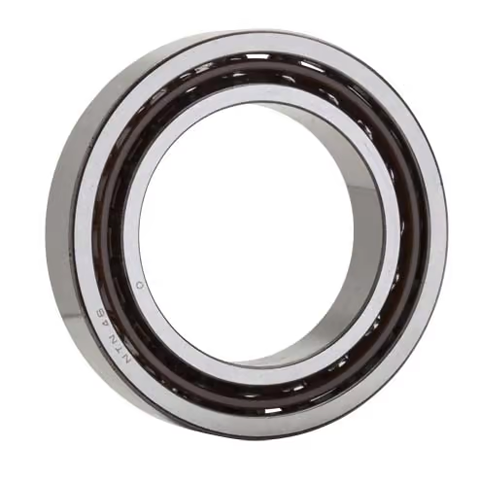
NTN NTN Angular Contact Ball Bearing , 7217
Item # d D B r Static Load Rating Dynamic Load Rating 7217 3.3465 in 85.000 mm 5.9055 in 150.000 mm 1.1024 in 28.000 mm 0.0787 in 2.000 mm 19900 lbf 88500 N 88.50 kN 22400 lbf 99500 N 99.50 kN 1. Design features and characteristics 1.1 Angular contact ball bearing Angular contact ball bearings are non-separable bearings with a defined contact angle in the radial direction relative to the straight line that runs through the point where each ball makes contact with the inner and outer rings (see Fig. 1). Table 1 provides information on contact angles and their designated codes. In addition to radial loads, angular contact ball bearings can accommodate single direction axial loads. Since an axial load is generated from a radial force, these bearings are generally used in pairs. Table 2 shows general angular contact ball bearing characteristics, Table 3 shows information on using duplex (side by side) angular contact ball bearings, and Table 4 shows information on multiple-row angular contact ball bearings. For bearings with a contact angle of 15° and bearing tolerance JIS Class 5 or higher, see special catalog “Precision rolling bearings (CAT. No. 2260/E)”. 1.2 Four-point angular contact ball bearings Four-point angular contact ball bearings have a contact angle of 30° and a split inner ring. As shown in Fig. 2, when the inner and outer rings receive a radial load, the ball contacts the inner and outer rings at four points. This construction enables a single bearing to accommodate axial loads from either direction, and when under a simple axial load or heavy axial load, the bearing relies on two contact points like ordinary bearings. 1.3 Double row angular contact ball bearings The structure of double row angular contact ball bearings is designed by arranging two single row angular contact bearings back-to-back in duplex (DB) to form a single bearing with a contact angle of 25°.These bearings are capable of accommodating radial loads, axial loads in either direction, and have a high capacity for moment loads.As shown in Fig. 4, sealed and shielded type double row angular contact ball bearings are also available. Standard loads vary from those of open type bearings.
$78.45
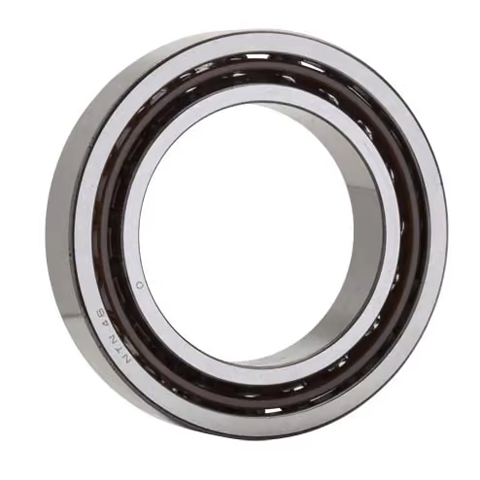
NTN NTN Angular Contact Ball Bearing , 7218
Item # d D B r Static Load Rating Dynamic Load Rating 7218 3.5433 in 90.000 mm 6.2992 in 160.000 mm 1.1811 in 30.000 mm 0.0787 in 2.000 mm 23200 lbf 103000 N 103.00 kN 26500 lbf 118000 N 118.00 kN 1. Design features and characteristics 1.1 Angular contact ball bearing Angular contact ball bearings are non-separable bearings with a defined contact angle in the radial direction relative to the straight line that runs through the point where each ball makes contact with the inner and outer rings (see Fig. 1). Table 1 provides information on contact angles and their designated codes. In addition to radial loads, angular contact ball bearings can accommodate single direction axial loads. Since an axial load is generated from a radial force, these bearings are generally used in pairs. Table 2 shows general angular contact ball bearing characteristics, Table 3 shows information on using duplex (side by side) angular contact ball bearings, and Table 4 shows information on multiple-row angular contact ball bearings. For bearings with a contact angle of 15° and bearing tolerance JIS Class 5 or higher, see special catalog “Precision rolling bearings (CAT. No. 2260/E)”. 1.2 Four-point angular contact ball bearings Four-point angular contact ball bearings have a contact angle of 30° and a split inner ring. As shown in Fig. 2, when the inner and outer rings receive a radial load, the ball contacts the inner and outer rings at four points. This construction enables a single bearing to accommodate axial loads from either direction, and when under a simple axial load or heavy axial load, the bearing relies on two contact points like ordinary bearings. 1.3 Double row angular contact ball bearings The structure of double row angular contact ball bearings is designed by arranging two single row angular contact bearings back-to-back in duplex (DB) to form a single bearing with a contact angle of 25°.These bearings are capable of accommodating radial loads, axial loads in either direction, and have a high capacity for moment loads.As shown in Fig. 4, sealed and shielded type double row angular contact ball bearings are also available. Standard loads vary from those of open type bearings.
$89.82
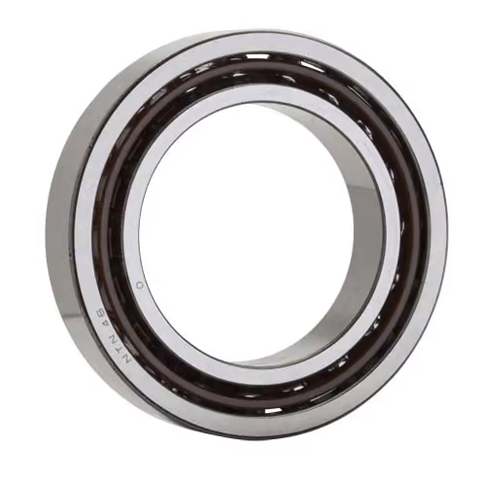
NTN NTN Angular Contact Ball Bearing , 7219
Item # d D B r Static Load Rating Dynamic Load Rating 7219 3.7402 in 95.000 mm 6.6929 in 170.000 mm 1.2598 in 32.000 mm 0.0827 in 2.100 mm 26500 lbf 118000 N 118.00 kN 29900 lbf 133000 N 133.00 kN 1. Design features and characteristics 1.1 Angular contact ball bearing Angular contact ball bearings are non-separable bearings with a defined contact angle in the radial direction relative to the straight line that runs through the point where each ball makes contact with the inner and outer rings (see Fig. 1). Table 1 provides information on contact angles and their designated codes. In addition to radial loads, angular contact ball bearings can accommodate single direction axial loads. Since an axial load is generated from a radial force, these bearings are generally used in pairs. Table 2 shows general angular contact ball bearing characteristics, Table 3 shows information on using duplex (side by side) angular contact ball bearings, and Table 4 shows information on multiple-row angular contact ball bearings. For bearings with a contact angle of 15° and bearing tolerance JIS Class 5 or higher, see special catalog “Precision rolling bearings (CAT. No. 2260/E)”. 1.2 Four-point angular contact ball bearings Four-point angular contact ball bearings have a contact angle of 30° and a split inner ring. As shown in Fig. 2, when the inner and outer rings receive a radial load, the ball contacts the inner and outer rings at four points. This construction enables a single bearing to accommodate axial loads from either direction, and when under a simple axial load or heavy axial load, the bearing relies on two contact points like ordinary bearings. 1.3 Double row angular contact ball bearings The structure of double row angular contact ball bearings is designed by arranging two single row angular contact bearings back-to-back in duplex (DB) to form a single bearing with a contact angle of 25°.These bearings are capable of accommodating radial loads, axial loads in either direction, and have a high capacity for moment loads.As shown in Fig. 4, sealed and shielded type double row angular contact ball bearings are also available. Standard loads vary from those of open type bearings.
$101.31
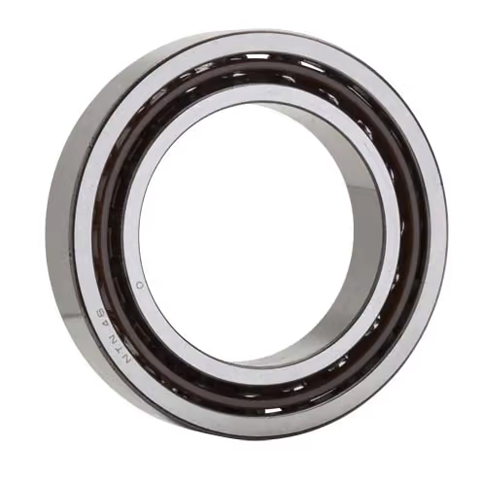
NTN NTN Angular Contact Ball Bearing , 7221
Item # d D B r Static Load Rating Dynamic Load Rating 7221 4.1339 in 105.000 mm 7.4803 in 190.000 mm 1.4173 in 36.000 mm 0.0827 in 2.100 mm 32000 lbf 142000 N 142.00 kN 35500 lbf 157000 N 157.00 kN 1. Design features and characteristics 1.1 Angular contact ball bearing Angular contact ball bearings are non-separable bearings with a defined contact angle in the radial direction relative to the straight line that runs through the point where each ball makes contact with the inner and outer rings (see Fig. 1). Table 1 provides information on contact angles and their designated codes. In addition to radial loads, angular contact ball bearings can accommodate single direction axial loads. Since an axial load is generated from a radial force, these bearings are generally used in pairs. Table 2 shows general angular contact ball bearing characteristics, Table 3 shows information on using duplex (side by side) angular contact ball bearings, and Table 4 shows information on multiple-row angular contact ball bearings. For bearings with a contact angle of 15° and bearing tolerance JIS Class 5 or higher, see special catalog “Precision rolling bearings (CAT. No. 2260/E)”. 1.2 Four-point angular contact ball bearings Four-point angular contact ball bearings have a contact angle of 30° and a split inner ring. As shown in Fig. 2, when the inner and outer rings receive a radial load, the ball contacts the inner and outer rings at four points. This construction enables a single bearing to accommodate axial loads from either direction, and when under a simple axial load or heavy axial load, the bearing relies on two contact points like ordinary bearings. 1.3 Double row angular contact ball bearings The structure of double row angular contact ball bearings is designed by arranging two single row angular contact bearings back-to-back in duplex (DB) to form a single bearing with a contact angle of 25°.These bearings are capable of accommodating radial loads, axial loads in either direction, and have a high capacity for moment loads.As shown in Fig. 4, sealed and shielded type double row angular contact ball bearings are also available. Standard loads vary from those of open type bearings.
$177.92
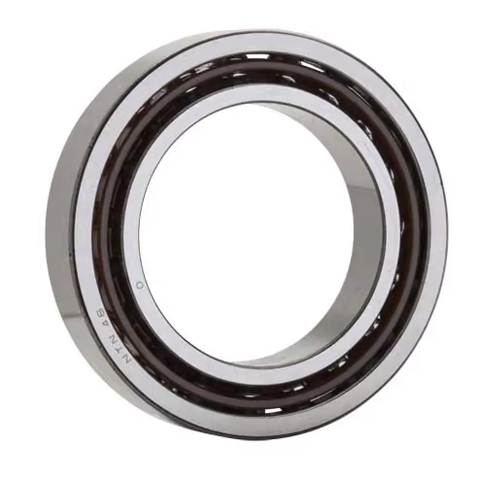
NTN NTN Angular Contact Ball Bearing , 7222
Item # d D B r Static Load Rating Dynamic Load Rating 7222 4.3307 in 110.000 mm 7.8740 in 200.000 mm 1.4961 in 38.000 mm 0.0827 in 2.100 mm 35500 lbf 158000 N 158.00 kN 38000 lbf 170000 N 170.00 kN 1. Design features and characteristics 1.1 Angular contact ball bearing Angular contact ball bearings are non-separable bearings with a defined contact angle in the radial direction relative to the straight line that runs through the point where each ball makes contact with the inner and outer rings (see Fig. 1). Table 1 provides information on contact angles and their designated codes. In addition to radial loads, angular contact ball bearings can accommodate single direction axial loads. Since an axial load is generated from a radial force, these bearings are generally used in pairs. Table 2 shows general angular contact ball bearing characteristics, Table 3 shows information on using duplex (side by side) angular contact ball bearings, and Table 4 shows information on multiple-row angular contact ball bearings. For bearings with a contact angle of 15° and bearing tolerance JIS Class 5 or higher, see special catalog “Precision rolling bearings (CAT. No. 2260/E)”. 1.2 Four-point angular contact ball bearings Four-point angular contact ball bearings have a contact angle of 30° and a split inner ring. As shown in Fig. 2, when the inner and outer rings receive a radial load, the ball contacts the inner and outer rings at four points. This construction enables a single bearing to accommodate axial loads from either direction, and when under a simple axial load or heavy axial load, the bearing relies on two contact points like ordinary bearings. 1.3 Double row angular contact ball bearings The structure of double row angular contact ball bearings is designed by arranging two single row angular contact bearings back-to-back in duplex (DB) to form a single bearing with a contact angle of 25°.These bearings are capable of accommodating radial loads, axial loads in either direction, and have a high capacity for moment loads.As shown in Fig. 4, sealed and shielded type double row angular contact ball bearings are also available. Standard loads vary from those of open type bearings.
$209.14
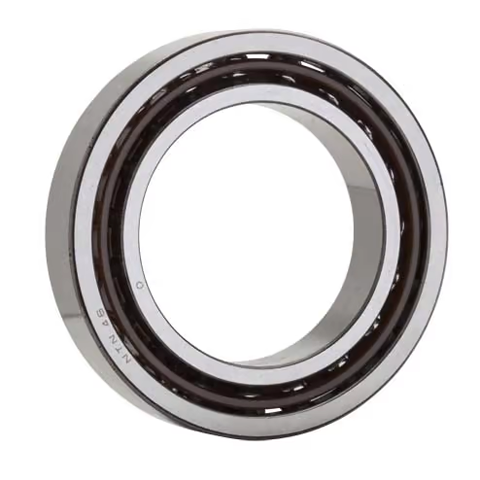
NTN NTN Angular Contact Ball Bearing , 7224
Item # d D B r Static Load Rating Dynamic Load Rating 7224 4.7244 in 120.000 mm 8.4646 in 215.000 mm 1.5748 in 40.000 mm 0.0827 in 2.100 mm 40000 lbf 177000 N 177.00 kN 41000 lbf 183000 N 183.00 kN 1. Design features and characteristics 1.1 Angular contact ball bearing Angular contact ball bearings are non-separable bearings with a defined contact angle in the radial direction relative to the straight line that runs through the point where each ball makes contact with the inner and outer rings (see Fig. 1). Table 1 provides information on contact angles and their designated codes. In addition to radial loads, angular contact ball bearings can accommodate single direction axial loads. Since an axial load is generated from a radial force, these bearings are generally used in pairs. Table 2 shows general angular contact ball bearing characteristics, Table 3 shows information on using duplex (side by side) angular contact ball bearings, and Table 4 shows information on multiple-row angular contact ball bearings. For bearings with a contact angle of 15° and bearing tolerance JIS Class 5 or higher, see special catalog “Precision rolling bearings (CAT. No. 2260/E)”. 1.2 Four-point angular contact ball bearings Four-point angular contact ball bearings have a contact angle of 30° and a split inner ring. As shown in Fig. 2, when the inner and outer rings receive a radial load, the ball contacts the inner and outer rings at four points. This construction enables a single bearing to accommodate axial loads from either direction, and when under a simple axial load or heavy axial load, the bearing relies on two contact points like ordinary bearings. 1.3 Double row angular contact ball bearings The structure of double row angular contact ball bearings is designed by arranging two single row angular contact bearings back-to-back in duplex (DB) to form a single bearing with a contact angle of 25°.These bearings are capable of accommodating radial loads, axial loads in either direction, and have a high capacity for moment loads.As shown in Fig. 4, sealed and shielded type double row angular contact ball bearings are also available. Standard loads vary from those of open type bearings.
$372.56
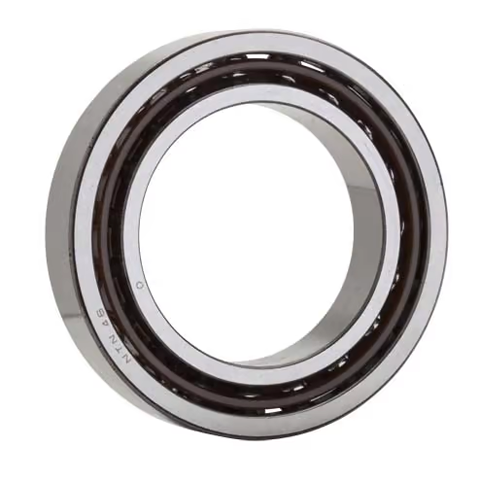
NTN NTN Angular Contact Ball Bearing , 7226
Item # d D B r Static Load Rating Dynamic Load Rating 7226 5.1181 in 130.000 mm 9.0551 in 230.000 mm 1.5748 in 40.000 mm 0.1181 in 3.000 mm 44500 lbf 198000 N 198.00 kN 44000 lbf 196000 N 196.00 kN 1. Design features and characteristics 1.1 Angular contact ball bearing Angular contact ball bearings are non-separable bearings with a defined contact angle in the radial direction relative to the straight line that runs through the point where each ball makes contact with the inner and outer rings (see Fig. 1). Table 1 provides information on contact angles and their designated codes. In addition to radial loads, angular contact ball bearings can accommodate single direction axial loads. Since an axial load is generated from a radial force, these bearings are generally used in pairs. Table 2 shows general angular contact ball bearing characteristics, Table 3 shows information on using duplex (side by side) angular contact ball bearings, and Table 4 shows information on multiple-row angular contact ball bearings. For bearings with a contact angle of 15° and bearing tolerance JIS Class 5 or higher, see special catalog “Precision rolling bearings (CAT. No. 2260/E)”. 1.2 Four-point angular contact ball bearings Four-point angular contact ball bearings have a contact angle of 30° and a split inner ring. As shown in Fig. 2, when the inner and outer rings receive a radial load, the ball contacts the inner and outer rings at four points. This construction enables a single bearing to accommodate axial loads from either direction, and when under a simple axial load or heavy axial load, the bearing relies on two contact points like ordinary bearings. 1.3 Double row angular contact ball bearings The structure of double row angular contact ball bearings is designed by arranging two single row angular contact bearings back-to-back in duplex (DB) to form a single bearing with a contact angle of 25°.These bearings are capable of accommodating radial loads, axial loads in either direction, and have a high capacity for moment loads.As shown in Fig. 4, sealed and shielded type double row angular contact ball bearings are also available. Standard loads vary from those of open type bearings.
$468.79
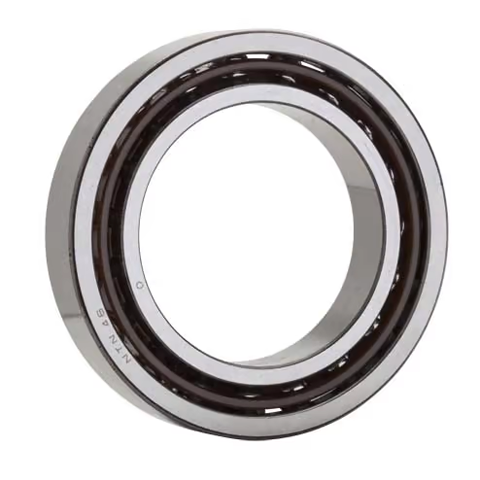
NTN NTN Angular Contact Ball Bearing , 7228
Item # d D B r Static Load Rating Dynamic Load Rating 7228 5.5118 in 140.000 mm 9.8425 in 250.000 mm 1.6535 in 42.000 mm 0.1181 in 3.000 mm 48500 lbf 215000 N 215.00 kN 45500 lbf 203000 N 203.00 kN 1. Design features and characteristics 1.1 Angular contact ball bearing Angular contact ball bearings are non-separable bearings with a defined contact angle in the radial direction relative to the straight line that runs through the point where each ball makes contact with the inner and outer rings (see Fig. 1). Table 1 provides information on contact angles and their designated codes. In addition to radial loads, angular contact ball bearings can accommodate single direction axial loads. Since an axial load is generated from a radial force, these bearings are generally used in pairs. Table 2 shows general angular contact ball bearing characteristics, Table 3 shows information on using duplex (side by side) angular contact ball bearings, and Table 4 shows information on multiple-row angular contact ball bearings. For bearings with a contact angle of 15° and bearing tolerance JIS Class 5 or higher, see special catalog “Precision rolling bearings (CAT. No. 2260/E)”. 1.2 Four-point angular contact ball bearings Four-point angular contact ball bearings have a contact angle of 30° and a split inner ring. As shown in Fig. 2, when the inner and outer rings receive a radial load, the ball contacts the inner and outer rings at four points. This construction enables a single bearing to accommodate axial loads from either direction, and when under a simple axial load or heavy axial load, the bearing relies on two contact points like ordinary bearings. 1.3 Double row angular contact ball bearings The structure of double row angular contact ball bearings is designed by arranging two single row angular contact bearings back-to-back in duplex (DB) to form a single bearing with a contact angle of 25°.These bearings are capable of accommodating radial loads, axial loads in either direction, and have a high capacity for moment loads.As shown in Fig. 4, sealed and shielded type double row angular contact ball bearings are also available. Standard loads vary from those of open type bearings.
$517.50
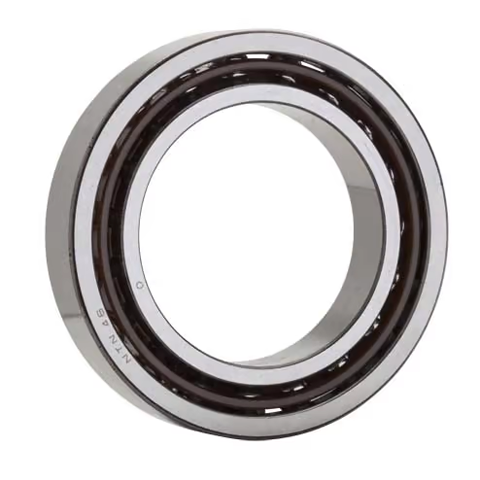
NTN NTN Angular Contact Ball Bearing , 7230
Item # d D B r Static Load Rating Dynamic Load Rating 7230 5.9055 in 150.000 mm 10.6299 in 270.000 mm 1.7717 in 45.000 mm 0.1181 in 3.000 mm 58000 lbf 259000 N 259.00 kN 52000 lbf 232000 N 232.00 kN 1. Design features and characteristics 1.1 Angular contact ball bearing Angular contact ball bearings are non-separable bearings with a defined contact angle in the radial direction relative to the straight line that runs through the point where each ball makes contact with the inner and outer rings (see Fig. 1). Table 1 provides information on contact angles and their designated codes. In addition to radial loads, angular contact ball bearings can accommodate single direction axial loads. Since an axial load is generated from a radial force, these bearings are generally used in pairs. Table 2 shows general angular contact ball bearing characteristics, Table 3 shows information on using duplex (side by side) angular contact ball bearings, and Table 4 shows information on multiple-row angular contact ball bearings. For bearings with a contact angle of 15° and bearing tolerance JIS Class 5 or higher, see special catalog “Precision rolling bearings (CAT. No. 2260/E)”. 1.2 Four-point angular contact ball bearings Four-point angular contact ball bearings have a contact angle of 30° and a split inner ring. As shown in Fig. 2, when the inner and outer rings receive a radial load, the ball contacts the inner and outer rings at four points. This construction enables a single bearing to accommodate axial loads from either direction, and when under a simple axial load or heavy axial load, the bearing relies on two contact points like ordinary bearings. 1.3 Double row angular contact ball bearings The structure of double row angular contact ball bearings is designed by arranging two single row angular contact bearings back-to-back in duplex (DB) to form a single bearing with a contact angle of 25°.These bearings are capable of accommodating radial loads, axial loads in either direction, and have a high capacity for moment loads.As shown in Fig. 4, sealed and shielded type double row angular contact ball bearings are also available. Standard loads vary from those of open type bearings.
$746.13
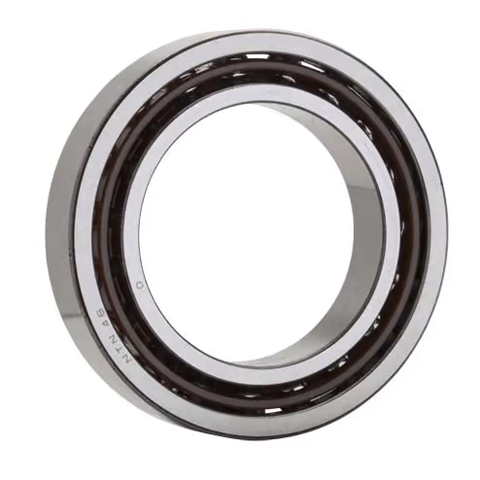
NTN NTN Angular Contact Ball Bearing , 7232
Item # d D B r Static Load Rating Dynamic Load Rating 7232 6.2992 in 160.000 mm 11.4173 in 290.000 mm 1.8898 in 48.000 mm 0.1181 in 3.000 mm 68500 lbf 305000 N 305.00 kN 59000 lbf 263000 N 263.00 kN 1. Design features and characteristics 1.1 Angular contact ball bearing Angular contact ball bearings are non-separable bearings with a defined contact angle in the radial direction relative to the straight line that runs through the point where each ball makes contact with the inner and outer rings (see Fig. 1). Table 1 provides information on contact angles and their designated codes. In addition to radial loads, angular contact ball bearings can accommodate single direction axial loads. Since an axial load is generated from a radial force, these bearings are generally used in pairs. Table 2 shows general angular contact ball bearing characteristics, Table 3 shows information on using duplex (side by side) angular contact ball bearings, and Table 4 shows information on multiple-row angular contact ball bearings. For bearings with a contact angle of 15° and bearing tolerance JIS Class 5 or higher, see special catalog “Precision rolling bearings (CAT. No. 2260/E)”. 1.2 Four-point angular contact ball bearings Four-point angular contact ball bearings have a contact angle of 30° and a split inner ring. As shown in Fig. 2, when the inner and outer rings receive a radial load, the ball contacts the inner and outer rings at four points. This construction enables a single bearing to accommodate axial loads from either direction, and when under a simple axial load or heavy axial load, the bearing relies on two contact points like ordinary bearings. 1.3 Double row angular contact ball bearings The structure of double row angular contact ball bearings is designed by arranging two single row angular contact bearings back-to-back in duplex (DB) to form a single bearing with a contact angle of 25°.These bearings are capable of accommodating radial loads, axial loads in either direction, and have a high capacity for moment loads.As shown in Fig. 4, sealed and shielded type double row angular contact ball bearings are also available. Standard loads vary from those of open type bearings.
$790.20
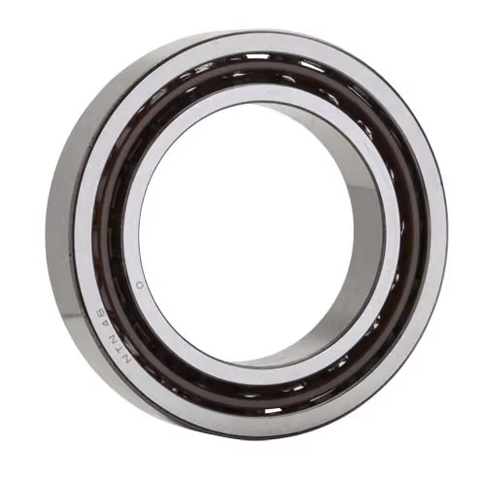
NTN NTN Angular Contact Ball Bearing , 7300
Item # d D B r Static Load Rating Dynamic Load Rating 7300 0.3937 in 10.000 mm 1.3780 in 35.000 mm 0.4331 in 11.000 mm 0.0236 in 0.600 mm 1110 lbf 4950 N 4.95 kN 2270 lbf 10100 N 10.10 kN 1. Design features and characteristics 1.1 Angular contact ball bearing Angular contact ball bearings are non-separable bearings with a defined contact angle in the radial direction relative to the straight line that runs through the point where each ball makes contact with the inner and outer rings (see Fig. 1). Table 1 provides information on contact angles and their designated codes. In addition to radial loads, angular contact ball bearings can accommodate single direction axial loads. Since an axial load is generated from a radial force, these bearings are generally used in pairs. Table 2 shows general angular contact ball bearing characteristics, Table 3 shows information on using duplex (side by side) angular contact ball bearings, and Table 4 shows information on multiple-row angular contact ball bearings. For bearings with a contact angle of 15° and bearing tolerance JIS Class 5 or higher, see special catalog “Precision rolling bearings (CAT. No. 2260/E)”. 1.2 Four-point angular contact ball bearings Four-point angular contact ball bearings have a contact angle of 30° and a split inner ring. As shown in Fig. 2, when the inner and outer rings receive a radial load, the ball contacts the inner and outer rings at four points. This construction enables a single bearing to accommodate axial loads from either direction, and when under a simple axial load or heavy axial load, the bearing relies on two contact points like ordinary bearings. 1.3 Double row angular contact ball bearings The structure of double row angular contact ball bearings is designed by arranging two single row angular contact bearings back-to-back in duplex (DB) to form a single bearing with a contact angle of 25°.These bearings are capable of accommodating radial loads, axial loads in either direction, and have a high capacity for moment loads.As shown in Fig. 4, sealed and shielded type double row angular contact ball bearings are also available. Standard loads vary from those of open type bearings.
$8.76
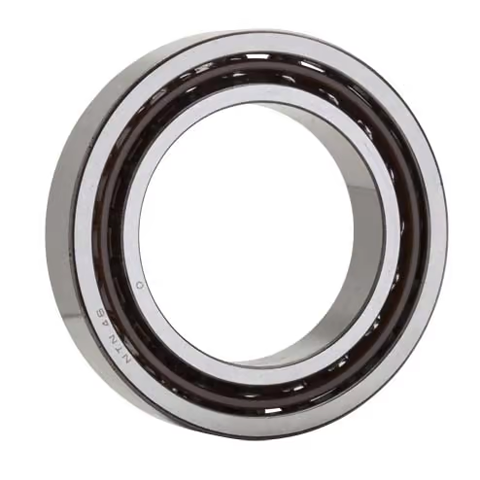
NTN NTN Angular Contact Ball Bearing , 7301
Item # d D B r Static Load Rating Dynamic Load Rating 7301 0.4724 in 12.000 mm 1.4567 in 37.000 mm 0.4724 in 12.000 mm 0.0394 in 1.000 mm 1180 lbf 5250 N 5.25 kN 2520 lbf 11200 N 11.20 kN 1. Design features and characteristics 1.1 Angular contact ball bearing Angular contact ball bearings are non-separable bearings with a defined contact angle in the radial direction relative to the straight line that runs through the point where each ball makes contact with the inner and outer rings (see Fig. 1). Table 1 provides information on contact angles and their designated codes. In addition to radial loads, angular contact ball bearings can accommodate single direction axial loads. Since an axial load is generated from a radial force, these bearings are generally used in pairs. Table 2 shows general angular contact ball bearing characteristics, Table 3 shows information on using duplex (side by side) angular contact ball bearings, and Table 4 shows information on multiple-row angular contact ball bearings. For bearings with a contact angle of 15° and bearing tolerance JIS Class 5 or higher, see special catalog “Precision rolling bearings (CAT. No. 2260/E)”. 1.2 Four-point angular contact ball bearings Four-point angular contact ball bearings have a contact angle of 30° and a split inner ring. As shown in Fig. 2, when the inner and outer rings receive a radial load, the ball contacts the inner and outer rings at four points. This construction enables a single bearing to accommodate axial loads from either direction, and when under a simple axial load or heavy axial load, the bearing relies on two contact points like ordinary bearings. 1.3 Double row angular contact ball bearings The structure of double row angular contact ball bearings is designed by arranging two single row angular contact bearings back-to-back in duplex (DB) to form a single bearing with a contact angle of 25°.These bearings are capable of accommodating radial loads, axial loads in either direction, and have a high capacity for moment loads.As shown in Fig. 4, sealed and shielded type double row angular contact ball bearings are also available. Standard loads vary from those of open type bearings.
$9.65
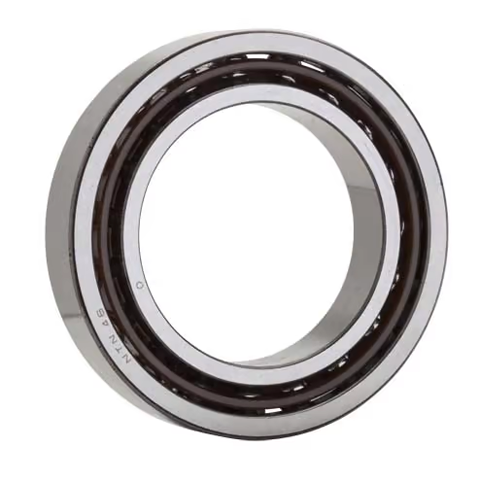
NTN NTN Angular Contact Ball Bearing , 7305
Item # d D B r Static Load Rating Dynamic Load Rating 7305 0.9843 in 25.000 mm 2.4409 in 62.000 mm 0.6693 in 17.000 mm 0.0433 in 1.100 mm 3550 lbf 15800 N 15.80 kN 5950 lbf 26400 N 26.40 kN 1. Design features and characteristics 1.1 Angular contact ball bearing Angular contact ball bearings are non-separable bearings with a defined contact angle in the radial direction relative to the straight line that runs through the point where each ball makes contact with the inner and outer rings (see Fig. 1). Table 1 provides information on contact angles and their designated codes. In addition to radial loads, angular contact ball bearings can accommodate single direction axial loads. Since an axial load is generated from a radial force, these bearings are generally used in pairs. Table 2 shows general angular contact ball bearing characteristics, Table 3 shows information on using duplex (side by side) angular contact ball bearings, and Table 4 shows information on multiple-row angular contact ball bearings. For bearings with a contact angle of 15° and bearing tolerance JIS Class 5 or higher, see special catalog “Precision rolling bearings (CAT. No. 2260/E)”. 1.2 Four-point angular contact ball bearings Four-point angular contact ball bearings have a contact angle of 30° and a split inner ring. As shown in Fig. 2, when the inner and outer rings receive a radial load, the ball contacts the inner and outer rings at four points. This construction enables a single bearing to accommodate axial loads from either direction, and when under a simple axial load or heavy axial load, the bearing relies on two contact points like ordinary bearings. 1.3 Double row angular contact ball bearings The structure of double row angular contact ball bearings is designed by arranging two single row angular contact bearings back-to-back in duplex (DB) to form a single bearing with a contact angle of 25°.These bearings are capable of accommodating radial loads, axial loads in either direction, and have a high capacity for moment loads.As shown in Fig. 4, sealed and shielded type double row angular contact ball bearings are also available. Standard loads vary from those of open type bearings.
$12.39
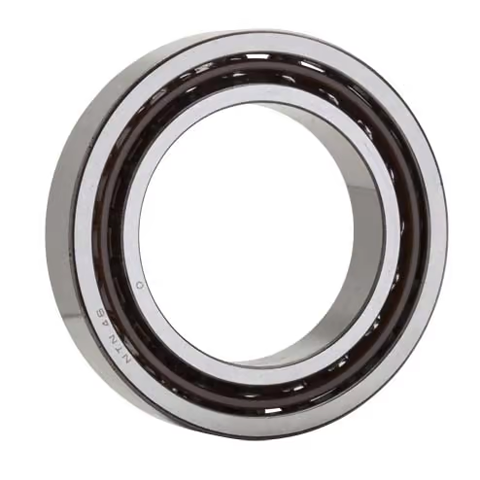
NTN NTN Angular Contact Ball Bearing , 7306
Item # d D B r Static Load Rating Dynamic Load Rating 7306 1.1811 in 30.000 mm 2.8346 in 72.000 mm 0.7480 in 19.000 mm 0.0433 in 1.100 mm 5000 lbf 22300 N 22.30 kN 7550 lbf 33500 N 33.50 kN 1. Design features and characteristics 1.1 Angular contact ball bearing Angular contact ball bearings are non-separable bearings with a defined contact angle in the radial direction relative to the straight line that runs through the point where each ball makes contact with the inner and outer rings (see Fig. 1). Table 1 provides information on contact angles and their designated codes. In addition to radial loads, angular contact ball bearings can accommodate single direction axial loads. Since an axial load is generated from a radial force, these bearings are generally used in pairs. Table 2 shows general angular contact ball bearing characteristics, Table 3 shows information on using duplex (side by side) angular contact ball bearings, and Table 4 shows information on multiple-row angular contact ball bearings. For bearings with a contact angle of 15° and bearing tolerance JIS Class 5 or higher, see special catalog “Precision rolling bearings (CAT. No. 2260/E)”. 1.2 Four-point angular contact ball bearings Four-point angular contact ball bearings have a contact angle of 30° and a split inner ring. As shown in Fig. 2, when the inner and outer rings receive a radial load, the ball contacts the inner and outer rings at four points. This construction enables a single bearing to accommodate axial loads from either direction, and when under a simple axial load or heavy axial load, the bearing relies on two contact points like ordinary bearings. 1.3 Double row angular contact ball bearings The structure of double row angular contact ball bearings is designed by arranging two single row angular contact bearings back-to-back in duplex (DB) to form a single bearing with a contact angle of 25°.These bearings are capable of accommodating radial loads, axial loads in either direction, and have a high capacity for moment loads.As shown in Fig. 4, sealed and shielded type double row angular contact ball bearings are also available. Standard loads vary from those of open type bearings.
$15.11
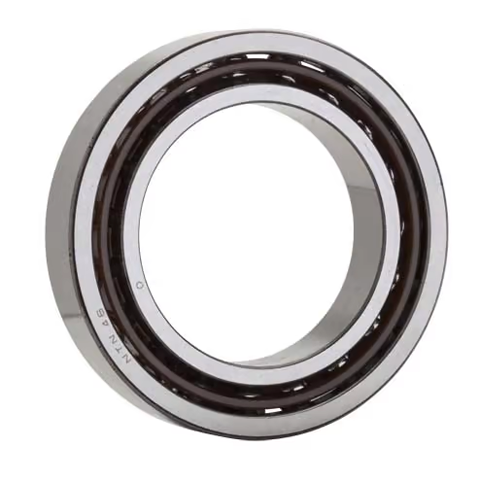
NTN NTN Angular Contact Ball Bearing , 7307
Item # d D B r Static Load Rating Dynamic Load Rating 7307 1.3780 in 35.000 mm 3.1496 in 80.000 mm 0.8268 in 21.000 mm 0.0591 in 1.500 mm 5900 lbf 26300 N 26.30 kN 9000 lbf 40000 N 40.00 kN 1. Design features and characteristics 1.1 Angular contact ball bearing Angular contact ball bearings are non-separable bearings with a defined contact angle in the radial direction relative to the straight line that runs through the point where each ball makes contact with the inner and outer rings (see Fig. 1). Table 1 provides information on contact angles and their designated codes. In addition to radial loads, angular contact ball bearings can accommodate single direction axial loads. Since an axial load is generated from a radial force, these bearings are generally used in pairs. Table 2 shows general angular contact ball bearing characteristics, Table 3 shows information on using duplex (side by side) angular contact ball bearings, and Table 4 shows information on multiple-row angular contact ball bearings. For bearings with a contact angle of 15° and bearing tolerance JIS Class 5 or higher, see special catalog “Precision rolling bearings (CAT. No. 2260/E)”. 1.2 Four-point angular contact ball bearings Four-point angular contact ball bearings have a contact angle of 30° and a split inner ring. As shown in Fig. 2, when the inner and outer rings receive a radial load, the ball contacts the inner and outer rings at four points. This construction enables a single bearing to accommodate axial loads from either direction, and when under a simple axial load or heavy axial load, the bearing relies on two contact points like ordinary bearings. 1.3 Double row angular contact ball bearings The structure of double row angular contact ball bearings is designed by arranging two single row angular contact bearings back-to-back in duplex (DB) to form a single bearing with a contact angle of 25°.These bearings are capable of accommodating radial loads, axial loads in either direction, and have a high capacity for moment loads.As shown in Fig. 4, sealed and shielded type double row angular contact ball bearings are also available. Standard loads vary from those of open type bearings.
$17.94
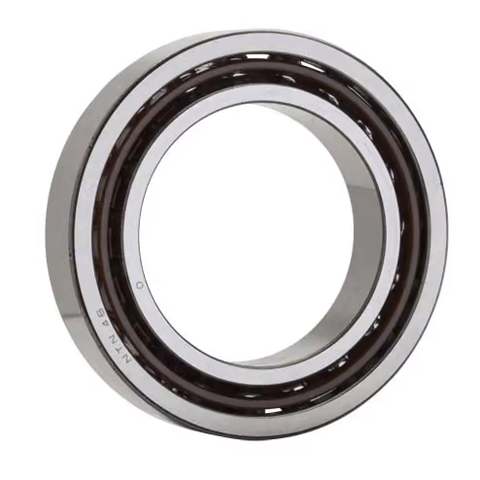
NTN NTN Angular Contact Ball Bearing , 7309
Item # d D B r Static Load Rating Dynamic Load Rating 7309 1.7717 in 45.000 mm 3.9370 in 100.000 mm 0.9843 in 25.000 mm 0.0591 in 1.500 mm 9900 lbf 44000 N 44.00 kN 14300 lbf 63500 N 63.50 kN 1. Design features and characteristics 1.1 Angular contact ball bearing Angular contact ball bearings are non-separable bearings with a defined contact angle in the radial direction relative to the straight line that runs through the point where each ball makes contact with the inner and outer rings (see Fig. 1). Table 1 provides information on contact angles and their designated codes. In addition to radial loads, angular contact ball bearings can accommodate single direction axial loads. Since an axial load is generated from a radial force, these bearings are generally used in pairs. Table 2 shows general angular contact ball bearing characteristics, Table 3 shows information on using duplex (side by side) angular contact ball bearings, and Table 4 shows information on multiple-row angular contact ball bearings. For bearings with a contact angle of 15° and bearing tolerance JIS Class 5 or higher, see special catalog “Precision rolling bearings (CAT. No. 2260/E)”. 1.2 Four-point angular contact ball bearings Four-point angular contact ball bearings have a contact angle of 30° and a split inner ring. As shown in Fig. 2, when the inner and outer rings receive a radial load, the ball contacts the inner and outer rings at four points. This construction enables a single bearing to accommodate axial loads from either direction, and when under a simple axial load or heavy axial load, the bearing relies on two contact points like ordinary bearings. 1.3 Double row angular contact ball bearings The structure of double row angular contact ball bearings is designed by arranging two single row angular contact bearings back-to-back in duplex (DB) to form a single bearing with a contact angle of 25°.These bearings are capable of accommodating radial loads, axial loads in either direction, and have a high capacity for moment loads.As shown in Fig. 4, sealed and shielded type double row angular contact ball bearings are also available. Standard loads vary from those of open type bearings.
$29.62
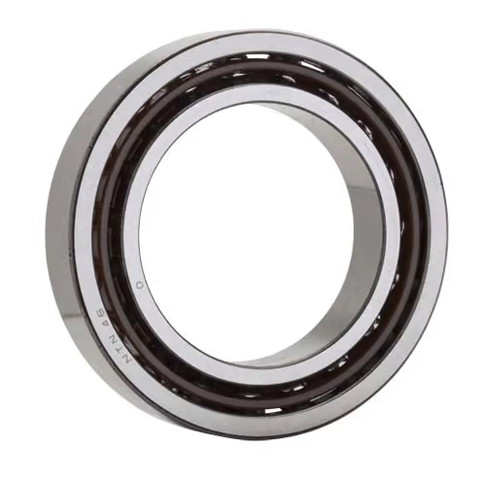
NTN NTN Angular Contact Ball Bearing ,7008
Item # d D B r Static Load Rating Dynamic Load Rating 7008 1.5748 in 40.000 mm 2.6772 in 68.000 mm 0.5906 in 15.000 mm 0.0394 in 1.000 mm 3300 lbf 14600 N 14.60 kN 4250 lbf 18800 N 18.80 kN 1. Design features and characteristics 1.1 Angular contact ball bearing Angular contact ball bearings are non-separable bearings with a defined contact angle in the radial direction relative to the straight line that runs through the point where each ball makes contact with the inner and outer rings (see Fig. 1). Table 1 provides information on contact angles and their designated codes. In addition to radial loads, angular contact ball bearings can accommodate single direction axial loads. Since an axial load is generated from a radial force, these bearings are generally used in pairs. Table 2 shows general angular contact ball bearing characteristics, Table 3 shows information on using duplex (side by side) angular contact ball bearings, and Table 4 shows information on multiple-row angular contact ball bearings. For bearings with a contact angle of 15° and bearing tolerance JIS Class 5 or higher, see special catalog “Precision rolling bearings (CAT. No. 2260/E)”. 1.2 Four-point angular contact ball bearings Four-point angular contact ball bearings have a contact angle of 30° and a split inner ring. As shown in Fig. 2, when the inner and outer rings receive a radial load, the ball contacts the inner and outer rings at four points. This construction enables a single bearing to accommodate axial loads from either direction, and when under a simple axial load or heavy axial load, the bearing relies on two contact points like ordinary bearings. 1.3 Double row angular contact ball bearings The structure of double row angular contact ball bearings is designed by arranging two single row angular contact bearings back-to-back in duplex (DB) to form a single bearing with a contact angle of 25°.These bearings are capable of accommodating radial loads, axial loads in either direction, and have a high capacity for moment loads.As shown in Fig. 4, sealed and shielded type double row angular contact ball bearings are also available. Standard loads vary from those of open type bearings.
$21.65
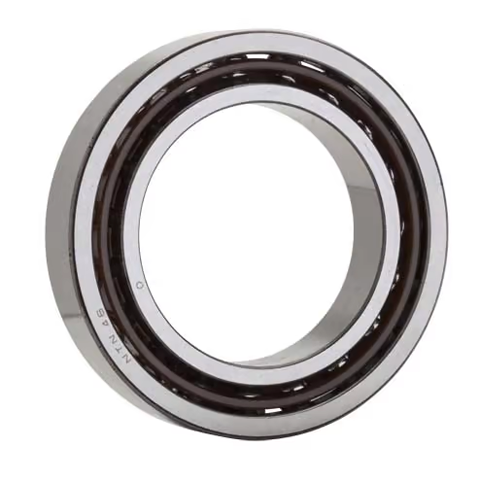
NTN NTN Angular Contact Ball Bearing ,7009
Item # d D B r Static Load Rating Dynamic Load Rating 7009 1.7717 in 45.000 mm 2.9528 in 75.000 mm 0.6299 in 16.000 mm 0.0394 in 1.000 mm 4000 lbf 17700 N 17.70 kN 5000 lbf 22300 N 22.30 kN 1. Design features and characteristics 1.1 Angular contact ball bearing Angular contact ball bearings are non-separable bearings with a defined contact angle in the radial direction relative to the straight line that runs through the point where each ball makes contact with the inner and outer rings (see Fig. 1). Table 1 provides information on contact angles and their designated codes. In addition to radial loads, angular contact ball bearings can accommodate single direction axial loads. Since an axial load is generated from a radial force, these bearings are generally used in pairs. Table 2 shows general angular contact ball bearing characteristics, Table 3 shows information on using duplex (side by side) angular contact ball bearings, and Table 4 shows information on multiple-row angular contact ball bearings. For bearings with a contact angle of 15° and bearing tolerance JIS Class 5 or higher, see special catalog “Precision rolling bearings (CAT. No. 2260/E)”. 1.2 Four-point angular contact ball bearings Four-point angular contact ball bearings have a contact angle of 30° and a split inner ring. As shown in Fig. 2, when the inner and outer rings receive a radial load, the ball contacts the inner and outer rings at four points. This construction enables a single bearing to accommodate axial loads from either direction, and when under a simple axial load or heavy axial load, the bearing relies on two contact points like ordinary bearings. 1.3 Double row angular contact ball bearings The structure of double row angular contact ball bearings is designed by arranging two single row angular contact bearings back-to-back in duplex (DB) to form a single bearing with a contact angle of 25°.These bearings are capable of accommodating radial loads, axial loads in either direction, and have a high capacity for moment loads.As shown in Fig. 4, sealed and shielded type double row angular contact ball bearings are also available. Standard loads vary from those of open type bearings.
$30.21
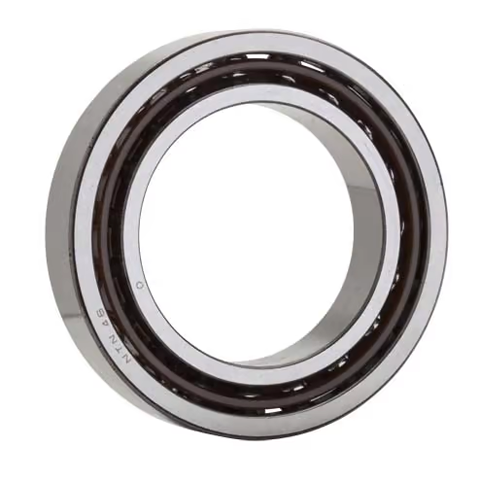
NTN NTN Angular Contact Ball Bearing ,7010
Item # d D B r Static Load Rating Dynamic Load Rating 7010 1.9685 in 50.000 mm 3.1496 in 80.000 mm 0.6299 in 16.000 mm 0.0394 in 1.000 mm 4500 lbf 20100 N 20.10 kN 5350 lbf 23700 N 23.70 kN 1. Design features and characteristics 1.1 Angular contact ball bearing Angular contact ball bearings are non-separable bearings with a defined contact angle in the radial direction relative to the straight line that runs through the point where each ball makes contact with the inner and outer rings (see Fig. 1). Table 1 provides information on contact angles and their designated codes. In addition to radial loads, angular contact ball bearings can accommodate single direction axial loads. Since an axial load is generated from a radial force, these bearings are generally used in pairs. Table 2 shows general angular contact ball bearing characteristics, Table 3 shows information on using duplex (side by side) angular contact ball bearings, and Table 4 shows information on multiple-row angular contact ball bearings. For bearings with a contact angle of 15° and bearing tolerance JIS Class 5 or higher, see special catalog “Precision rolling bearings (CAT. No. 2260/E)”. 1.2 Four-point angular contact ball bearings Four-point angular contact ball bearings have a contact angle of 30° and a split inner ring. As shown in Fig. 2, when the inner and outer rings receive a radial load, the ball contacts the inner and outer rings at four points. This construction enables a single bearing to accommodate axial loads from either direction, and when under a simple axial load or heavy axial load, the bearing relies on two contact points like ordinary bearings. 1.3 Double row angular contact ball bearings The structure of double row angular contact ball bearings is designed by arranging two single row angular contact bearings back-to-back in duplex (DB) to form a single bearing with a contact angle of 25°.These bearings are capable of accommodating radial loads, axial loads in either direction, and have a high capacity for moment loads.As shown in Fig. 4, sealed and shielded type double row angular contact ball bearings are also available. Standard loads vary from those of open type bearings.
$31.36
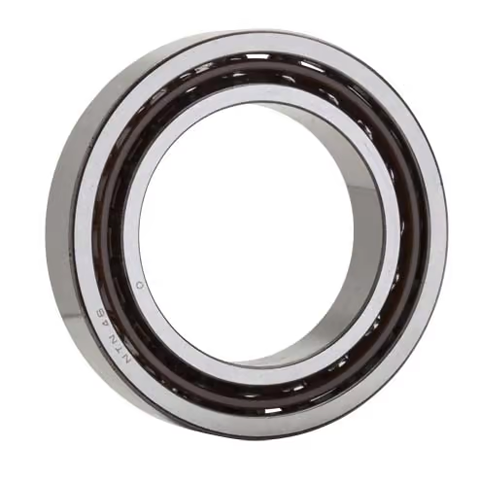
NTN NTN Angular Contact Ball Bearing ,7011
Item # d D B r Static Load Rating Dynamic Load Rating 7011 2.1654 in 55.000 mm 3.5433 in 90.000 mm 0.7087 in 18.000 mm 0.0433 in 1.100 mm 5900 lbf 26300 N 26.30 kN 6950 lbf 31000 N 31.00 kN 1. Design features and characteristics 1.1 Angular contact ball bearing Angular contact ball bearings are non-separable bearings with a defined contact angle in the radial direction relative to the straight line that runs through the point where each ball makes contact with the inner and outer rings (see Fig. 1). Table 1 provides information on contact angles and their designated codes. In addition to radial loads, angular contact ball bearings can accommodate single direction axial loads. Since an axial load is generated from a radial force, these bearings are generally used in pairs. Table 2 shows general angular contact ball bearing characteristics, Table 3 shows information on using duplex (side by side) angular contact ball bearings, and Table 4 shows information on multiple-row angular contact ball bearings. For bearings with a contact angle of 15° and bearing tolerance JIS Class 5 or higher, see special catalog “Precision rolling bearings (CAT. No. 2260/E)”. 1.2 Four-point angular contact ball bearings Four-point angular contact ball bearings have a contact angle of 30° and a split inner ring. As shown in Fig. 2, when the inner and outer rings receive a radial load, the ball contacts the inner and outer rings at four points. This construction enables a single bearing to accommodate axial loads from either direction, and when under a simple axial load or heavy axial load, the bearing relies on two contact points like ordinary bearings. 1.3 Double row angular contact ball bearings The structure of double row angular contact ball bearings is designed by arranging two single row angular contact bearings back-to-back in duplex (DB) to form a single bearing with a contact angle of 25°.These bearings are capable of accommodating radial loads, axial loads in either direction, and have a high capacity for moment loads.As shown in Fig. 4, sealed and shielded type double row angular contact ball bearings are also available. Standard loads vary from those of open type bearings.
$41.76
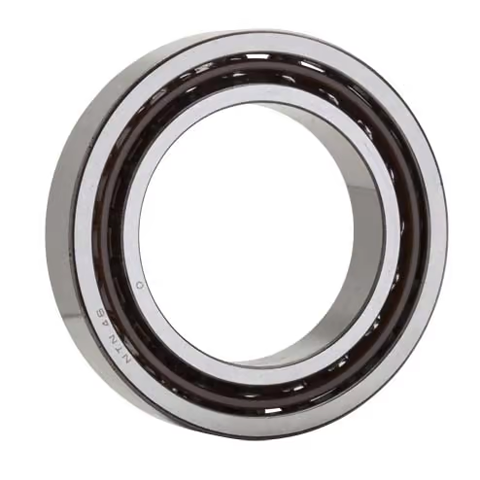
NTN NTN Angular Contact Ball Bearing ,7012
Item # d D B r Static Load Rating Dynamic Load Rating 7012 2.3622 in 60.000 mm 3.7402 in 95.000 mm 0.7087 in 18.000 mm 0.0433 in 1.100 mm 6300 lbf 28100 N 28.10 kN 7200 lbf 32000 N 32.00 kN 1. Design features and characteristics 1.1 Angular contact ball bearing Angular contact ball bearings are non-separable bearings with a defined contact angle in the radial direction relative to the straight line that runs through the point where each ball makes contact with the inner and outer rings (see Fig. 1). Table 1 provides information on contact angles and their designated codes. In addition to radial loads, angular contact ball bearings can accommodate single direction axial loads. Since an axial load is generated from a radial force, these bearings are generally used in pairs. Table 2 shows general angular contact ball bearing characteristics, Table 3 shows information on using duplex (side by side) angular contact ball bearings, and Table 4 shows information on multiple-row angular contact ball bearings. For bearings with a contact angle of 15° and bearing tolerance JIS Class 5 or higher, see special catalog “Precision rolling bearings (CAT. No. 2260/E)”. 1.2 Four-point angular contact ball bearings Four-point angular contact ball bearings have a contact angle of 30° and a split inner ring. As shown in Fig. 2, when the inner and outer rings receive a radial load, the ball contacts the inner and outer rings at four points. This construction enables a single bearing to accommodate axial loads from either direction, and when under a simple axial load or heavy axial load, the bearing relies on two contact points like ordinary bearings. 1.3 Double row angular contact ball bearings The structure of double row angular contact ball bearings is designed by arranging two single row angular contact bearings back-to-back in duplex (DB) to form a single bearing with a contact angle of 25°.These bearings are capable of accommodating radial loads, axial loads in either direction, and have a high capacity for moment loads.As shown in Fig. 4, sealed and shielded type double row angular contact ball bearings are also available. Standard loads vary from those of open type bearings.
$44.33
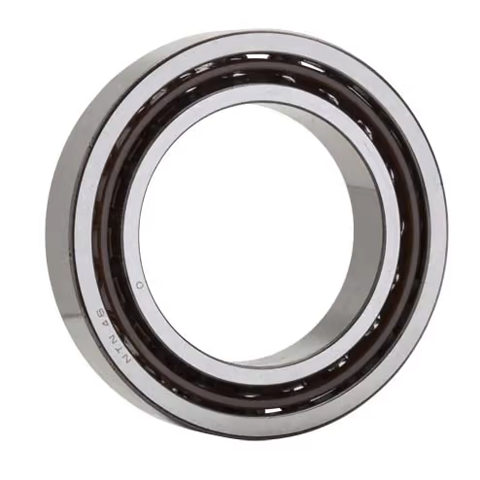
NTN NTN Angular Contact Ball Bearing ,7013
Item # d D B r Static Load Rating Dynamic Load Rating 7013 2.5591 in 65.000 mm 3.9370 in 100.000 mm 0.7087 in 18.000 mm 0.0433 in 1.100 mm 7100 lbf 31500 N 31.50 kN 7550 lbf 33500 N 33.50 kN 1. Design features and characteristics 1.1 Angular contact ball bearing Angular contact ball bearings are non-separable bearings with a defined contact angle in the radial direction relative to the straight line that runs through the point where each ball makes contact with the inner and outer rings (see Fig. 1). Table 1 provides information on contact angles and their designated codes. In addition to radial loads, angular contact ball bearings can accommodate single direction axial loads. Since an axial load is generated from a radial force, these bearings are generally used in pairs. Table 2 shows general angular contact ball bearing characteristics, Table 3 shows information on using duplex (side by side) angular contact ball bearings, and Table 4 shows information on multiple-row angular contact ball bearings. For bearings with a contact angle of 15° and bearing tolerance JIS Class 5 or higher, see special catalog “Precision rolling bearings (CAT. No. 2260/E)”. 1.2 Four-point angular contact ball bearings Four-point angular contact ball bearings have a contact angle of 30° and a split inner ring. As shown in Fig. 2, when the inner and outer rings receive a radial load, the ball contacts the inner and outer rings at four points. This construction enables a single bearing to accommodate axial loads from either direction, and when under a simple axial load or heavy axial load, the bearing relies on two contact points like ordinary bearings. 1.3 Double row angular contact ball bearings The structure of double row angular contact ball bearings is designed by arranging two single row angular contact bearings back-to-back in duplex (DB) to form a single bearing with a contact angle of 25°.These bearings are capable of accommodating radial loads, axial loads in either direction, and have a high capacity for moment loads.As shown in Fig. 4, sealed and shielded type double row angular contact ball bearings are also available. Standard loads vary from those of open type bearings.
$57.07
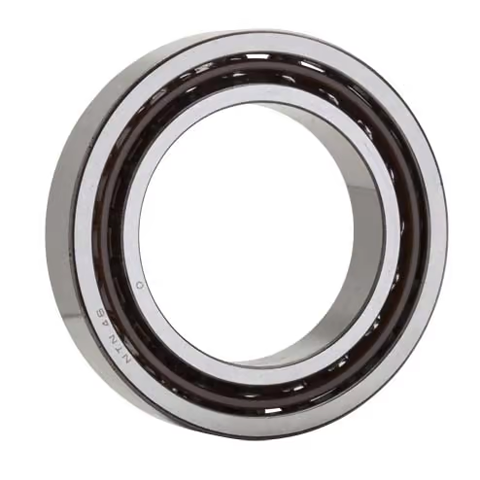
NTN NTN Angular Contact Ball Bearing ,7014
Item # d D B r Static Load Rating Dynamic Load Rating 7014 2.7559 in 70.000 mm 4.3307 in 110.000 mm 0.7874 in 20.000 mm 0.0433 in 1.100 mm 8900 lbf 39500 N 39.50 kN 9550 lbf 42500 N 42.50 kN 1. Design features and characteristics 1.1 Angular contact ball bearing Angular contact ball bearings are non-separable bearings with a defined contact angle in the radial direction relative to the straight line that runs through the point where each ball makes contact with the inner and outer rings (see Fig. 1). Table 1 provides information on contact angles and their designated codes. In addition to radial loads, angular contact ball bearings can accommodate single direction axial loads. Since an axial load is generated from a radial force, these bearings are generally used in pairs. Table 2 shows general angular contact ball bearing characteristics, Table 3 shows information on using duplex (side by side) angular contact ball bearings, and Table 4 shows information on multiple-row angular contact ball bearings. For bearings with a contact angle of 15° and bearing tolerance JIS Class 5 or higher, see special catalog “Precision rolling bearings (CAT. No. 2260/E)”. 1.2 Four-point angular contact ball bearings Four-point angular contact ball bearings have a contact angle of 30° and a split inner ring. As shown in Fig. 2, when the inner and outer rings receive a radial load, the ball contacts the inner and outer rings at four points. This construction enables a single bearing to accommodate axial loads from either direction, and when under a simple axial load or heavy axial load, the bearing relies on two contact points like ordinary bearings. 1.3 Double row angular contact ball bearings The structure of double row angular contact ball bearings is designed by arranging two single row angular contact bearings back-to-back in duplex (DB) to form a single bearing with a contact angle of 25°.These bearings are capable of accommodating radial loads, axial loads in either direction, and have a high capacity for moment loads.As shown in Fig. 4, sealed and shielded type double row angular contact ball bearings are also available. Standard loads vary from those of open type bearings.
$63.14
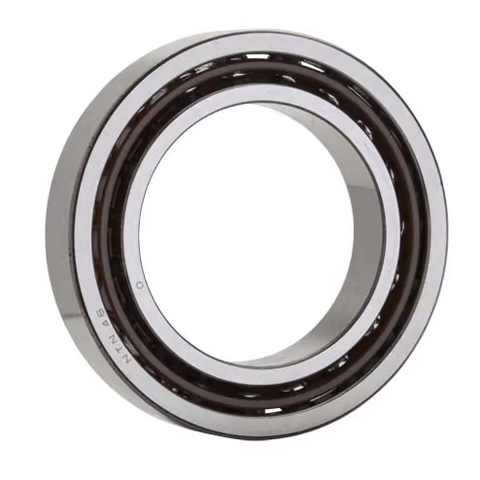
NTN NTN Angular Contact Ball Bearing ,7015
Item # d D B r Static Load Rating Dynamic Load Rating 7015 2.9528 in 75.000 mm 4.5276 in 115.000 mm 0.7874 in 20.000 mm 0.0433 in 1.100 mm 9350 lbf 41500 N 41.50 kN 9800 lbf 43500 N 43.50 kN 1. Design features and characteristics 1.1 Angular contact ball bearing Angular contact ball bearings are non-separable bearings with a defined contact angle in the radial direction relative to the straight line that runs through the point where each ball makes contact with the inner and outer rings (see Fig. 1). Table 1 provides information on contact angles and their designated codes. In addition to radial loads, angular contact ball bearings can accommodate single direction axial loads. Since an axial load is generated from a radial force, these bearings are generally used in pairs. Table 2 shows general angular contact ball bearing characteristics, Table 3 shows information on using duplex (side by side) angular contact ball bearings, and Table 4 shows information on multiple-row angular contact ball bearings. For bearings with a contact angle of 15° and bearing tolerance JIS Class 5 or higher, see special catalog “Precision rolling bearings (CAT. No. 2260/E)”. 1.2 Four-point angular contact ball bearings Four-point angular contact ball bearings have a contact angle of 30° and a split inner ring. As shown in Fig. 2, when the inner and outer rings receive a radial load, the ball contacts the inner and outer rings at four points. This construction enables a single bearing to accommodate axial loads from either direction, and when under a simple axial load or heavy axial load, the bearing relies on two contact points like ordinary bearings. 1.3 Double row angular contact ball bearings The structure of double row angular contact ball bearings is designed by arranging two single row angular contact bearings back-to-back in duplex (DB) to form a single bearing with a contact angle of 25°.These bearings are capable of accommodating radial loads, axial loads in either direction, and have a high capacity for moment loads.As shown in Fig. 4, sealed and shielded type double row angular contact ball bearings are also available. Standard loads vary from those of open type bearings.
$67.34
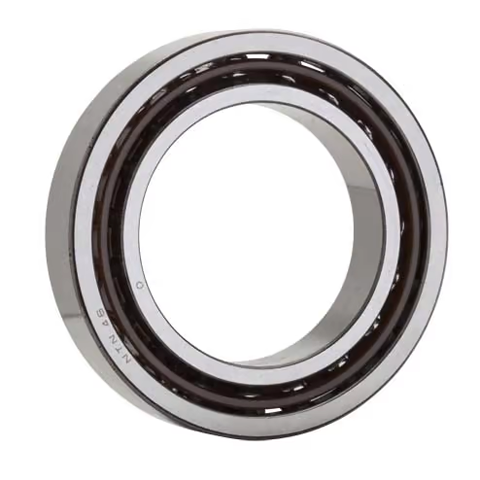
NTN NTN Angular Contact Bearing ,7000
Item # d D B r Static Load Rating Dynamic Load Rating 7000 0.3937 in 10.000 mm 1.0236 in 26.000 mm 0.3150 in 8.000 mm 0.0118 in 0.300 mm 465 lbf 2070 N 2.07 kN 1050 lbf 4650 N 4.65 kN 1. Design features and characteristics 1.1 Angular contact ball bearing Angular contact ball bearings are non-separable bearings with a defined contact angle in the radial direction relative to the straight line that runs through the point where each ball makes contact with the inner and outer rings (see Fig. 1). Table 1 provides information on contact angles and their designated codes. In addition to radial loads, angular contact ball bearings can accommodate single direction axial loads. Since an axial load is generated from a radial force, these bearings are generally used in pairs. Table 2 shows general angular contact ball bearing characteristics, Table 3 shows information on using duplex (side by side) angular contact ball bearings, and Table 4 shows information on multiple-row angular contact ball bearings. For bearings with a contact angle of 15° and bearing tolerance JIS Class 5 or higher, see special catalog “Precision rolling bearings (CAT. No. 2260/E)”. 1.2 Four-point angular contact ball bearings Four-point angular contact ball bearings have a contact angle of 30° and a split inner ring. As shown in Fig. 2, when the inner and outer rings receive a radial load, the ball contacts the inner and outer rings at four points. This construction enables a single bearing to accommodate axial loads from either direction, and when under a simple axial load or heavy axial load, the bearing relies on two contact points like ordinary bearings. 1.3 Double row angular contact ball bearings The structure of double row angular contact ball bearings is designed by arranging two single row angular contact bearings back-to-back in duplex (DB) to form a single bearing with a contact angle of 25°.These bearings are capable of accommodating radial loads, axial loads in either direction, and have a high capacity for moment loads.As shown in Fig. 4, sealed and shielded type double row angular contact ball bearings are also available. Standard loads vary from those of open type bearings.
$8.01
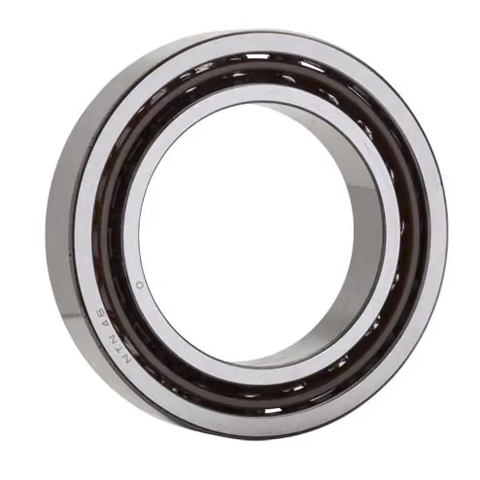
NTN NTN Angular Contact Bearing ,7001
Item # d D B r Static Load Rating Dynamic Load Rating 7001 0.4724 in 12.000 mm 1.1024 in 28.000 mm 0.3150 in 8.000 mm 0.0118 in 0.300 mm 555 lbf 2460 N 2.46 kN 1140 lbf 5050 N 5.05 kN 1. Design features and characteristics 1.1 Angular contact ball bearing Angular contact ball bearings are non-separable bearings with a defined contact angle in the radial direction relative to the straight line that runs through the point where each ball makes contact with the inner and outer rings (see Fig. 1). Table 1 provides information on contact angles and their designated codes. In addition to radial loads, angular contact ball bearings can accommodate single direction axial loads. Since an axial load is generated from a radial force, these bearings are generally used in pairs. Table 2 shows general angular contact ball bearing characteristics, Table 3 shows information on using duplex (side by side) angular contact ball bearings, and Table 4 shows information on multiple-row angular contact ball bearings. For bearings with a contact angle of 15° and bearing tolerance JIS Class 5 or higher, see special catalog “Precision rolling bearings (CAT. No. 2260/E)”. 1.2 Four-point angular contact ball bearings Four-point angular contact ball bearings have a contact angle of 30° and a split inner ring. As shown in Fig. 2, when the inner and outer rings receive a radial load, the ball contacts the inner and outer rings at four points. This construction enables a single bearing to accommodate axial loads from either direction, and when under a simple axial load or heavy axial load, the bearing relies on two contact points like ordinary bearings. 1.3 Double row angular contact ball bearings The structure of double row angular contact ball bearings is designed by arranging two single row angular contact bearings back-to-back in duplex (DB) to form a single bearing with a contact angle of 25°.These bearings are capable of accommodating radial loads, axial loads in either direction, and have a high capacity for moment loads.As shown in Fig. 4, sealed and shielded type double row angular contact ball bearings are also available. Standard loads vary from those of open type bearings.
$8.47
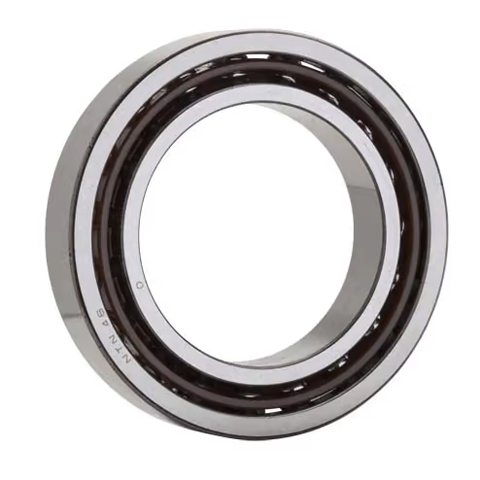
NTN NTN Angular Contact Bearing ,7002
Item # d D B r Static Load Rating Dynamic Load Rating 7002 0.5906 in 15.000 mm 1.2598 in 32.000 mm 0.3543 in 9.000 mm 0.0118 in 0.300 mm 710 lbf 3150 N 3.15 kN 1300 lbf 5800 N 5.80 kN 1. Design features and characteristics 1.1 Angular contact ball bearing Angular contact ball bearings are non-separable bearings with a defined contact angle in the radial direction relative to the straight line that runs through the point where each ball makes contact with the inner and outer rings (see Fig. 1). Table 1 provides information on contact angles and their designated codes. In addition to radial loads, angular contact ball bearings can accommodate single direction axial loads. Since an axial load is generated from a radial force, these bearings are generally used in pairs. Table 2 shows general angular contact ball bearing characteristics, Table 3 shows information on using duplex (side by side) angular contact ball bearings, and Table 4 shows information on multiple-row angular contact ball bearings. For bearings with a contact angle of 15° and bearing tolerance JIS Class 5 or higher, see special catalog “Precision rolling bearings (CAT. No. 2260/E)”. 1.2 Four-point angular contact ball bearings Four-point angular contact ball bearings have a contact angle of 30° and a split inner ring. As shown in Fig. 2, when the inner and outer rings receive a radial load, the ball contacts the inner and outer rings at four points. This construction enables a single bearing to accommodate axial loads from either direction, and when under a simple axial load or heavy axial load, the bearing relies on two contact points like ordinary bearings. 1.3 Double row angular contact ball bearings The structure of double row angular contact ball bearings is designed by arranging two single row angular contact bearings back-to-back in duplex (DB) to form a single bearing with a contact angle of 25°.These bearings are capable of accommodating radial loads, axial loads in either direction, and have a high capacity for moment loads.As shown in Fig. 4, sealed and shielded type double row angular contact ball bearings are also available. Standard loads vary from those of open type bearings.
$8.93
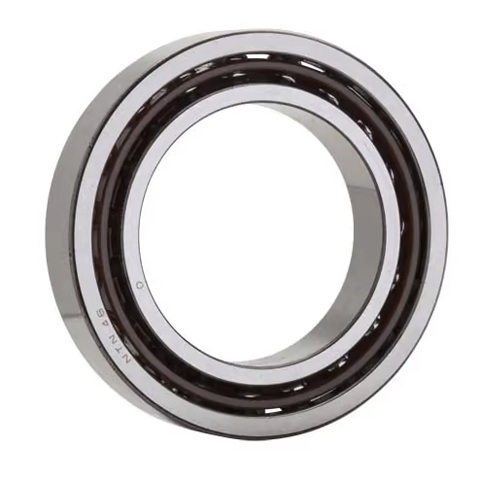
NTN NTN Angular Contact Bearing ,7003
Item # d D B r Static Load Rating Dynamic Load Rating 7003 0.6693 in 17.000 mm 1.3780 in 35.000 mm 0.3937 in 10.000 mm 0.0118 in 0.300 mm 865 lbf 3850 N 3.85 kN 1610 lbf 7150 N 7.15 kN 1. Design features and characteristics 1.1 Angular contact ball bearing Angular contact ball bearings are non-separable bearings with a defined contact angle in the radial direction relative to the straight line that runs through the point where each ball makes contact with the inner and outer rings (see Fig. 1). Table 1 provides information on contact angles and their designated codes. In addition to radial loads, angular contact ball bearings can accommodate single direction axial loads. Since an axial load is generated from a radial force, these bearings are generally used in pairs. Table 2 shows general angular contact ball bearing characteristics, Table 3 shows information on using duplex (side by side) angular contact ball bearings, and Table 4 shows information on multiple-row angular contact ball bearings. For bearings with a contact angle of 15° and bearing tolerance JIS Class 5 or higher, see special catalog “Precision rolling bearings (CAT. No. 2260/E)”. 1.2 Four-point angular contact ball bearings Four-point angular contact ball bearings have a contact angle of 30° and a split inner ring. As shown in Fig. 2, when the inner and outer rings receive a radial load, the ball contacts the inner and outer rings at four points. This construction enables a single bearing to accommodate axial loads from either direction, and when under a simple axial load or heavy axial load, the bearing relies on two contact points like ordinary bearings. 1.3 Double row angular contact ball bearings The structure of double row angular contact ball bearings is designed by arranging two single row angular contact bearings back-to-back in duplex (DB) to form a single bearing with a contact angle of 25°.These bearings are capable of accommodating radial loads, axial loads in either direction, and have a high capacity for moment loads.As shown in Fig. 4, sealed and shielded type double row angular contact ball bearings are also available. Standard loads vary from those of open type bearings.
$9.26
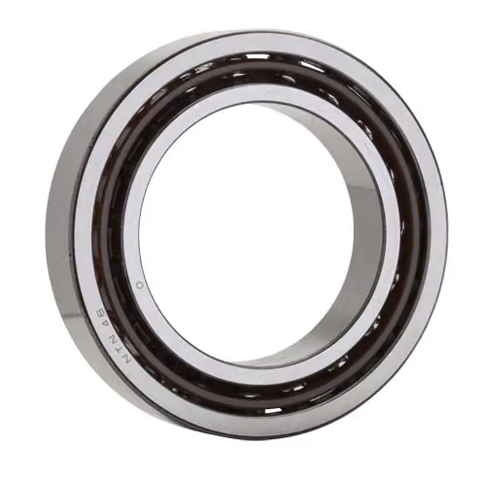
NTN NTN Angular Contact Bearing ,7004
Item # d D B r Static Load Rating Dynamic Load Rating 7004 0.7874 in 20.000 mm 1.6535 in 42.000 mm 0.4724 in 12.000 mm 0.0236 in 0.600 mm 1260 lbf 5600 N 5.60 kN 2180 lbf 9700 N 9.70 kN 1. Design features and characteristics 1.1 Angular contact ball bearing Angular contact ball bearings are non-separable bearings with a defined contact angle in the radial direction relative to the straight line that runs through the point where each ball makes contact with the inner and outer rings (see Fig. 1). Table 1 provides information on contact angles and their designated codes. In addition to radial loads, angular contact ball bearings can accommodate single direction axial loads. Since an axial load is generated from a radial force, these bearings are generally used in pairs. Table 2 shows general angular contact ball bearing characteristics, Table 3 shows information on using duplex (side by side) angular contact ball bearings, and Table 4 shows information on multiple-row angular contact ball bearings. For bearings with a contact angle of 15° and bearing tolerance JIS Class 5 or higher, see special catalog “Precision rolling bearings (CAT. No. 2260/E)”. 1.2 Four-point angular contact ball bearings Four-point angular contact ball bearings have a contact angle of 30° and a split inner ring. As shown in Fig. 2, when the inner and outer rings receive a radial load, the ball contacts the inner and outer rings at four points. This construction enables a single bearing to accommodate axial loads from either direction, and when under a simple axial load or heavy axial load, the bearing relies on two contact points like ordinary bearings. 1.3 Double row angular contact ball bearings The structure of double row angular contact ball bearings is designed by arranging two single row angular contact bearings back-to-back in duplex (DB) to form a single bearing with a contact angle of 25°.These bearings are capable of accommodating radial loads, axial loads in either direction, and have a high capacity for moment loads.As shown in Fig. 4, sealed and shielded type double row angular contact ball bearings are also available. Standard loads vary from those of open type bearings.
$9.72
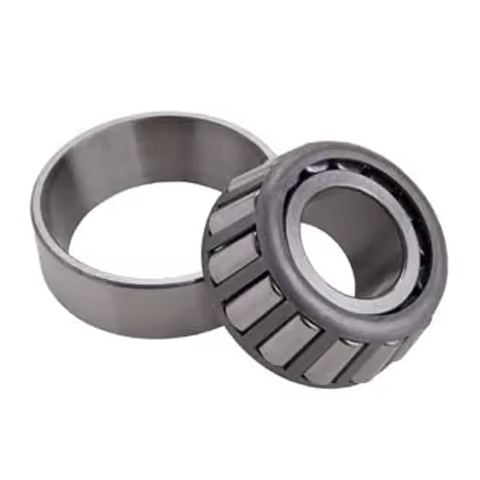
NTN NTN Tapered Roller Bearing Set - Metric Series, 30202
NTN 4T-30209 Single Row Tapered Roller Bearing (Inside Dia - 45mm, Outside Dia - 85mm) SPECIFICATIONS Type of Product : Single Row Tapered Roller Bearing Inside Diameter (d) (mm) : 45 Outside Diameter D (mm) : 85 Width Dia mm : 19 Model No : 4T-30209 1. Types, design features, and characteristics Tapered roller bearings are designed so the tapered vertex of the raceway surfaces of the inner and outer rings and rollers converge at one point on the centerline of the bearing (see Fig. 1).The tapered rollers are guided by the compound force of the inner and outer raceway surfaces which keep the rollers pressed up against the large rib on the inner ring.A large variety of these bearings, including single, double, and four row arrangements, are available in both metric and inch series. Each type and associated characteristics are shown in Table 1. For four-row tapered roller bearings, see section “C. Special application bearings.” Table 1 Tapered roller bearing types and characteristics Type Characteristics Single row taperedroller bearings (1) There are both metric and inch series adhering to the standards shown in the following table. Dimension series *Dimension series previously not covered by 3XX are regulated under JIS B 1512; dimensions previously missing from 3XX will henceforth use the bearing number. (2) In addition to the standard design, there are also medium contact angle and large contact angle types, denoted by the contact angle codes at the end of the part numbers (C and D, respectively). (3) Subunits Tapered roller bearings can be disassembled into parts: the inner ring, rollers, and cage (collectively known as the “CONE”) and the outer ring (known as the “CUP”). These are the bearing’s “subunits”. Subunit dimensions are standardized under ISO or ABMA standards, and unified subunits are interchangeable within each dimensional standard. However, high precision grade bearings are generally not interchangeable, and these subunits must be used by assembling only subunits with identical manufacturing numbers.Aside from any cautionary notes that may appear, the single row tapered roller bearings listed in the dimension tables have subunits standardized for both metric and inch systems (including J series). (Refer to Fig. 2) Single row taperedroller bearings (4) These bearings are constructed to have a high capacity for radial loads, axial loads, and combined loads. The larger the contact angle, the greater the axial load capacity. When a pure radial load is applied to a tapered roller bearing, an induced load in the axial direction is also generated, so these bearings are generally used in pairs.(5) Single row tapered roller bearings are separable, so both the inner and outer rings can be used with tight fits. (6) Tapered roller bearings are also manufactured with flanges attached to the outer rings. For more details, contact NTN Engineering. (Refer to Fig. 3) Duplex tapered roller bearings (1) When two single-row tapered roller bearings are to be used in combination, the bearing clearance and preload are adjusted by the inner ring spacer or the outer ring spacer (see Fig. 4).(2) A product number and a combination code are indicated on inner rings, outer rings, and spacers. Parts displaying the same number and code must be used in combination.(3) See A-96 Table 8.14 for the axial internal clearance. Double row taperedroller bearings (1) Back-to-back arrangement (using double row outer rings) and face-to-face arrangement (using double row inner rings) are both available. The assemblies have been adjusted so that each type's internal clearance values are fixed. Only parts with identical manufacturing numbers can be used and they must be assembled according to their code numbers. (Refer to Fig. 5)(2) See A-96 Table 8.14 for the axial internal clearance of double-row and duplex bearings. 2. Standard cage type In general, pressed cages (see Fig. 6) are used in tapered roller bearings. For large sized bearings, machined or pin type cages may also be used, while resin cages may also be used for smaller sized bearings. 3. Allowable misalignment In order to avoid edge loading and potential for premature failure, the maximum allowable misalignment based on bearing series can be found below.The allowable misalignment of combined bearings is influenced by the load center position, so please consult NTN Engineering.• Single row (standard) …………… 1/ 2 000• Single row (ULTAGE) …………… 1/ 600 4. Precautions If bearing load is light during operation, or if the ratio of axial to radial load for duplex and double row bearings exceeds the value of e, slipping may develop between the rollers and raceway surface, sometimes resulting in smearing. The mass of rollers and cages particularly tends to be large for large tapered roller bearings. For additional details, please contact NTN Engineering.In tapered roller bearings, the cage may protrude beyond the inner and/or outer ring side faces. Care should be taken when designing the housing and shaft to ensure contact with the cage does not occur.
$18.06
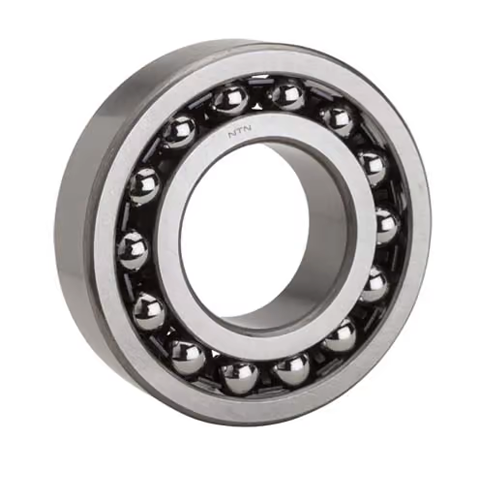
NTN NTN 1200 Self-Aligning Ball Bearing - Straight Bore, 10 mm ID, 30 mm OD, 9 mm Width, Open
NTN 1200 Self-Aligning Ball Bearing - Straight Bore, 10 mm ID, 30 mm OD, 9 mm Width, Open, CN SPECIFICATIONS Bore Type Cylindrical Bore Diameter 0.3937 in, 10.000 mm Outside Diameter 1.1811 in, 30.000 mm Overall Width 9.000 mm, 0.3543 in Closure Type Open Cage Type Fiber Glass Reinforced Internal Clearance CN Operating Temperature Range -40 to 250 ºF Seal Material None Dynamic Load Capacity 1250 lbf Seal Type None Static Load Capacity 268 lbf Precision Rating Class 0 Maximum RPM 28000 rpm Bearing Material High Carbon Chrome Steel Cage Material Nylon Finish/Coating Uncoated Harmonization Code 8482.10.5060 Outer Ring Width 0.3543 in; 9.000 mm Inner Ring Width 9.000 mm, 0.3543 in Fillet Radius 0.600 mm, 0.0236 in Series 12 Manufacturer UPC Number 4547359512946 Weight 0.071 lb 1. Design features and characteristics The outer ring raceway of self-aligning ball bearings forms a spherical surface whose center is common to the bearing center. The inner ring of the bearing has two raceways.The balls, cage, and inner ring of these bearings are capable of shifting in order to compensate for a certain degree of misalignment with the outer rings. As a result, the bearing is able to align itself and compensate for shaft / housing finishing unevenness, bearing fitting error, and other sources of misalignment as shown in Fig. 1.Since axial load capacity is limited, self- aligning ball bearing are not suitable for applications with heavy axial loads. It is recommended to use an adapter on a self-aligning ball bearing with a tapered bore inner diameter for ease of installation and disassembly. These bearings and adapters are often used on drive shaft applications. 2. Standard cage type All bearing series are equipped with a pressed cage, except 2321S and 2322S, which are equipped with a machined cage.Self-Aligning Ball BearingsIt is recommended to use an adapter on a self-aligning ball bearing with a tapered bore inner diameter for ease of installation and disassembly. These bearings and adapters are often used on drive shaft applications. Table 1 Standard cage types of spherical ball bearings 3. Ball protrusion Bearings with part numbers listed in Table 2 below have balls which protrude slightly from the bearing face as illustrated in Fig. 2. The total width dimensions are shown in Table 2. 4. Allowable misalignment angle The allowable misalignment angle can be determined by the following function. This degree of allowable misalignment may be limited by the design of mating components around the bearing.Normal load ....................... 1/15 5. Precautions for using self-aligning ball bearings Self-aligning ball bearings are unable to support large axial loads and therefore axial loading shall be limited.Please consider using self-aligning roller bearings when a large axial load is to be applied.
$5.41
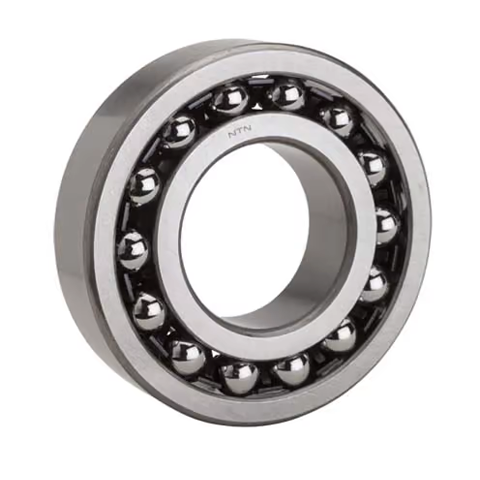
NTN NTN 1201 Self-Aligning Ball Bearing - Straight Bore, 12 mm ID, 32 mm OD, 10 mm Width, Open,
NTN 1201 Self-Aligning Ball Bearing - Straight Bore, 12 mm ID, 32 mm OD, 10 mm Width, Open, CN SPECIFICATIONS Bore Type Cylindrical Bore Diameter 0.4724 in, 12.000 mm Outside Diameter 1.2598 in, 32.000 mm Overall Width 0.3937 in, 10.000 mm Closure Type Open Cage Type Fiber Glass Reinforced Internal Clearance CN Operating Temperature Range -40 to 250 ºF Seal Material None Dynamic Load Capacity 1280 lbf Seal Type None Static Load Capacity 286 lbf Precision Rating Class 0 Maximum RPM 26000 rpm Bearing Material High Carbon Chrome Steel Cage Material Nylon Finish/Coating Uncoated Harmonization Code 8482.10.5060 Outer Ring Width 0.3937 in; 10.000 mm Inner Ring Width 0.3937 in, 10.000 mm Fillet Radius 0.600 mm, 0.0236 in Series 12 Manufacturer UPC Number 4547359512953 Weight 0.090 lb 1. Design features and characteristics The outer ring raceway of self-aligning ball bearings forms a spherical surface whose center is common to the bearing center. The inner ring of the bearing has two raceways.The balls, cage, and inner ring of these bearings are capable of shifting in order to compensate for a certain degree of misalignment with the outer rings. As a result, the bearing is able to align itself and compensate for shaft / housing finishing unevenness, bearing fitting error, and other sources of misalignment as shown in Fig. 1.Since axial load capacity is limited, self- aligning ball bearing are not suitable for applications with heavy axial loads. It is recommended to use an adapter on a self-aligning ball bearing with a tapered bore inner diameter for ease of installation and disassembly. These bearings and adapters are often used on drive shaft applications. 2. Standard cage type All bearing series are equipped with a pressed cage, except 2321S and 2322S, which are equipped with a machined cage.Self-Aligning Ball BearingsIt is recommended to use an adapter on a self-aligning ball bearing with a tapered bore inner diameter for ease of installation and disassembly. These bearings and adapters are often used on drive shaft applications. Table 1 Standard cage types of spherical ball bearings 3. Ball protrusion Bearings with part numbers listed in Table 2 below have balls which protrude slightly from the bearing face as illustrated in Fig. 2. The total width dimensions are shown in Table 2. 4. Allowable misalignment angle The allowable misalignment angle can be determined by the following function. This degree of allowable misalignment may be limited by the design of mating components around the bearing.Normal load ....................... 1/15 5. Precautions for using self-aligning ball bearings Self-aligning ball bearings are unable to support large axial loads and therefore axial loading shall be limited.Please consider using self-aligning roller bearings when a large axial load is to be applied.
$5.65
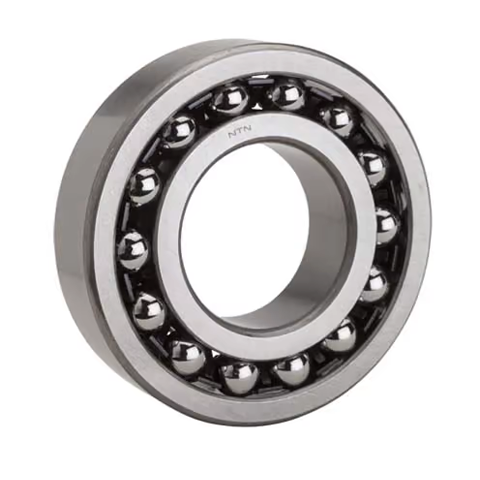
NTN NTN 1205 Self-Aligning Ball Bearing - Straight Bore, 25 mm ID, 52 mm OD, 15 mm Width, Open
NTN 1205 Self-Aligning Ball Bearing - Straight Bore, 25 mm ID, 52 mm OD, 15 mm Width, Open, CN SPECIFICATIONS Bore Type Cylindrical Bore Diameter 0.9843 in, 25.000 mm Outside Diameter 52.000 mm, 2.0472 in Overall Width 15.000 mm, 0.5906 in Closure Type Open Cage Type Fiber Glass Reinforced Internal Clearance CN Operating Temperature Range -40 to 250 ºF Seal Material None Dynamic Load Capacity 2740 lbf Seal Type None Static Load Capacity 740 lbf Precision Rating Class 0 Maximum RPM 14000 rpm Bearing Material High Carbon Chrome Steel Cage Material Nylon Finish/Coating Uncoated Harmonization Code 8482.10.5060 Outer Ring Width 0.5906 in; 15.000 mm Inner Ring Width 15.000 mm, 0.5906 in Fillet Radius 1.000 mm, 0.0394 in Series 12 Manufacturer UPC Number 4547359254822 Weight 0.291 lb 1. Design features and characteristics The outer ring raceway of self-aligning ball bearings forms a spherical surface whose center is common to the bearing center. The inner ring of the bearing has two raceways.The balls, cage, and inner ring of these bearings are capable of shifting in order to compensate for a certain degree of misalignment with the outer rings. As a result, the bearing is able to align itself and compensate for shaft / housing finishing unevenness, bearing fitting error, and other sources of misalignment as shown in Fig. 1.Since axial load capacity is limited, self- aligning ball bearing are not suitable for applications with heavy axial loads. It is recommended to use an adapter on a self-aligning ball bearing with a tapered bore inner diameter for ease of installation and disassembly. These bearings and adapters are often used on drive shaft applications. 2. Standard cage type All bearing series are equipped with a pressed cage, except 2321S and 2322S, which are equipped with a machined cage.Self-Aligning Ball BearingsIt is recommended to use an adapter on a self-aligning ball bearing with a tapered bore inner diameter for ease of installation and disassembly. These bearings and adapters are often used on drive shaft applications. Table 1 Standard cage types of spherical ball bearings 3. Ball protrusion Bearings with part numbers listed in Table 2 below have balls which protrude slightly from the bearing face as illustrated in Fig. 2. The total width dimensions are shown in Table 2. 4. Allowable misalignment angle The allowable misalignment angle can be determined by the following function. This degree of allowable misalignment may be limited by the design of mating components around the bearing.Normal load ....................... 1/15 5. Precautions for using self-aligning ball bearings Self-aligning ball bearings are unable to support large axial loads and therefore axial loading shall be limited.Please consider using self-aligning roller bearings when a large axial load is to be applied.
$8.70
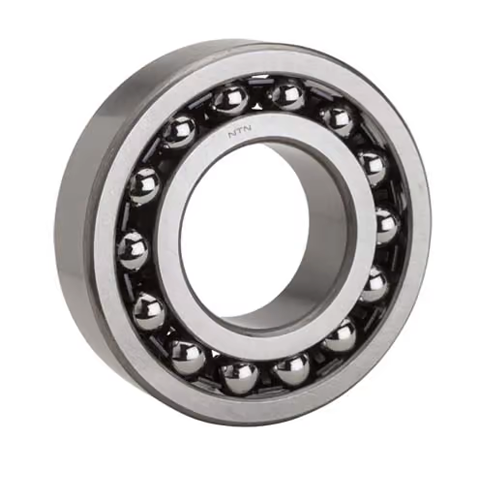
NTN NTN 1205K Self-Aligning Ball Bearing - Taper 1:12, 25 mm
NTN 1205K Self-Aligning Ball Bearing - Taper 1:12, 25 mm ID, 52 mm OD, 15 mm Width, Open, CN SPECIFICATIONS Bore Type Tapered Bore Diameter 0.9843 in, 25.000 mm Outside Diameter 52.000 mm, 2.0472 in Overall Width 15.000 mm, 0.5906 in Closure Type Open Cage Type Fiber Glass Reinforced Internal Clearance CN Operating Temperature Range -40 to 250 ºF Seal Material None Dynamic Load Capacity 2740 lbf Seal Type None Static Load Capacity 740 lbf Precision Rating Class 0 Maximum RPM 14000 rpm Bearing Material High Carbon Chrome Steel Cage Material Nylon Finish/Coating Uncoated Harmonization Code 8482.10.5060 Outer Ring Width 0.5906 in; 15.000 mm Inner Ring Width 15.000 mm, 0.5906 in Fillet Radius 1.000 mm, 0.0394 in Manufacturer UPC Number 4547359254877 Weight 0.289 lb 1. Design features and characteristics The outer ring raceway of self-aligning ball bearings forms a spherical surface whose center is common to the bearing center. The inner ring of the bearing has two raceways.The balls, cage, and inner ring of these bearings are capable of shifting in order to compensate for a certain degree of misalignment with the outer rings. As a result, the bearing is able to align itself and compensate for shaft / housing finishing unevenness, bearing fitting error, and other sources of misalignment as shown in Fig. 1.Since axial load capacity is limited, self- aligning ball bearing are not suitable for applications with heavy axial loads. It is recommended to use an adapter on a self-aligning ball bearing with a tapered bore inner diameter for ease of installation and disassembly. These bearings and adapters are often used on drive shaft applications. 2. Standard cage type All bearing series are equipped with a pressed cage, except 2321S and 2322S, which are equipped with a machined cage.Self-Aligning Ball BearingsIt is recommended to use an adapter on a self-aligning ball bearing with a tapered bore inner diameter for ease of installation and disassembly. These bearings and adapters are often used on drive shaft applications. Table 1 Standard cage types of spherical ball bearings 3. Ball protrusion Bearings with part numbers listed in Table 2 below have balls which protrude slightly from the bearing face as illustrated in Fig. 2. The total width dimensions are shown in Table 2. 4. Allowable misalignment angle The allowable misalignment angle can be determined by the following function. This degree of allowable misalignment may be limited by the design of mating components around the bearing.Normal load ....................... 1/15 5. Precautions for using self-aligning ball bearings Self-aligning ball bearings are unable to support large axial loads and therefore axial loading shall be limited.Please consider using self-aligning roller bearings when a large axial load is to be applied.
$9.83
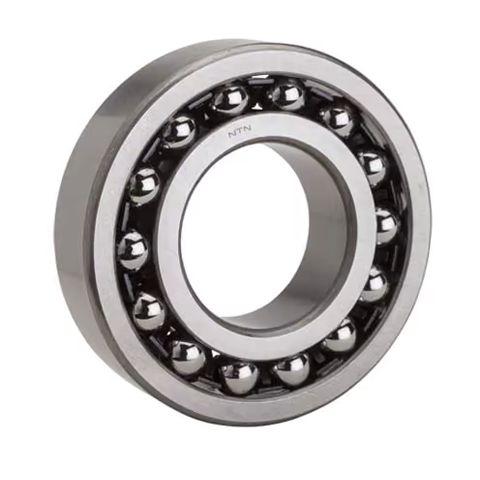
NTN NTN 1206K Self-Aligning Ball Bearing - Taper 1:12, 30 mm
NTN 1206K Self-Aligning Ball Bearing - Taper 1:12, 30 mm ID, 62 mm OD, 16 mm Width, Open, CN SPECIFICATIONS Bore Type Tapered Bore Diameter 1.1811 in, 30.000 mm Outside Diameter 62.000 mm, 2.4409 in Overall Width 16.000 mm, 0.6299 in Closure Type Open Cage Type Fiber Glass Reinforced Internal Clearance CN Operating Temperature Range -40 to 250 ºF Seal Material None Dynamic Load Capacity 3550 lbf Seal Type None Static Load Capacity 1050 lbf Precision Rating Class 0 Maximum RPM 12000 rpm Bearing Material High Carbon Chrome Steel Cage Material Nylon Finish/Coating Uncoated Harmonization Code 8482.10.5060 Outer Ring Width 0.6299 in; 16.000 mm Inner Ring Width 16.000 mm, 0.6299 in Fillet Radius 1.000 mm, 0.0394 in Manufacturer UPC Number 4547359254945 Weight 0.474 lb 1. Design features and characteristics The outer ring raceway of self-aligning ball bearings forms a spherical surface whose center is common to the bearing center. The inner ring of the bearing has two raceways.The balls, cage, and inner ring of these bearings are capable of shifting in order to compensate for a certain degree of misalignment with the outer rings. As a result, the bearing is able to align itself and compensate for shaft / housing finishing unevenness, bearing fitting error, and other sources of misalignment as shown in Fig. 1.Since axial load capacity is limited, self- aligning ball bearing are not suitable for applications with heavy axial loads. It is recommended to use an adapter on a self-aligning ball bearing with a tapered bore inner diameter for ease of installation and disassembly. These bearings and adapters are often used on drive shaft applications. 2. Standard cage type All bearing series are equipped with a pressed cage, except 2321S and 2322S, which are equipped with a machined cage.Self-Aligning Ball BearingsIt is recommended to use an adapter on a self-aligning ball bearing with a tapered bore inner diameter for ease of installation and disassembly. These bearings and adapters are often used on drive shaft applications. Table 1 Standard cage types of spherical ball bearings 3. Ball protrusion Bearings with part numbers listed in Table 2 below have balls which protrude slightly from the bearing face as illustrated in Fig. 2. The total width dimensions are shown in Table 2. 4. Allowable misalignment angle The allowable misalignment angle can be determined by the following function. This degree of allowable misalignment may be limited by the design of mating components around the bearing.Normal load ....................... 1/15 5. Precautions for using self-aligning ball bearings Self-aligning ball bearings are unable to support large axial loads and therefore axial loading shall be limited.Please consider using self-aligning roller bearings when a large axial load is to be applied.
$12.09
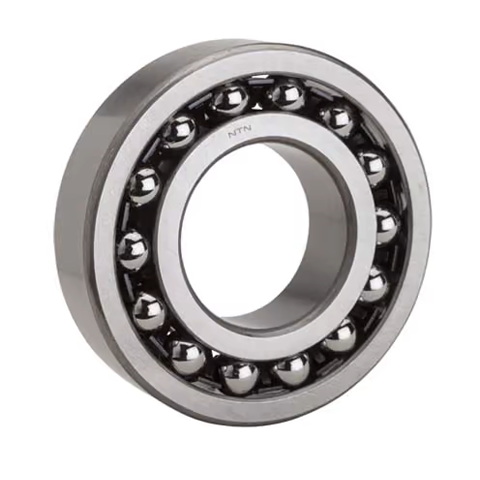
NTN NTN 1207K Self-Aligning Ball Bearing - Taper 1:12, 35 mm
NTN 1207K Self-Aligning Ball Bearing - Taper 1:12, 35 mm ID, 72 mm OD, 17 mm Width, Open, CN SPECIFICATIONS Bore Type Tapered Bore Diameter 35.000 mm, 1.3780 in Outside Diameter 72.000 mm, 2.8346 in Overall Width 17.000 mm, 0.6693 in Closure Type Open Cage Type Pressed Internal Clearance CN Operating Temperature Range -40 to 250 ºF Seal Material None Dynamic Load Capacity 3550 lbf Seal Type None Static Load Capacity 1150 lbf Precision Rating Class 0 Maximum RPM 10000 rpm Bearing Material High Carbon Chrome Steel Cage Material Steel Finish/Coating Uncoated Harmonization Code 8482.10.5060 Outer Ring Width 0.6693 in; 17.000 mm Inner Ring Width 17.000 mm, 0.6693 in Fillet Radius 1.100 mm, 0.0433 in Manufacturer UPC Number 4547359513172 Weight 0.694 lb 1. Design features and characteristics The outer ring raceway of self-aligning ball bearings forms a spherical surface whose center is common to the bearing center. The inner ring of the bearing has two raceways.The balls, cage, and inner ring of these bearings are capable of shifting in order to compensate for a certain degree of misalignment with the outer rings. As a result, the bearing is able to align itself and compensate for shaft / housing finishing unevenness, bearing fitting error, and other sources of misalignment as shown in Fig. 1.Since axial load capacity is limited, self- aligning ball bearing are not suitable for applications with heavy axial loads. It is recommended to use an adapter on a self-aligning ball bearing with a tapered bore inner diameter for ease of installation and disassembly. These bearings and adapters are often used on drive shaft applications. 2. Standard cage type All bearing series are equipped with a pressed cage, except 2321S and 2322S, which are equipped with a machined cage.Self-Aligning Ball BearingsIt is recommended to use an adapter on a self-aligning ball bearing with a tapered bore inner diameter for ease of installation and disassembly. These bearings and adapters are often used on drive shaft applications. Table 1 Standard cage types of spherical ball bearings 3. Ball protrusion Bearings with part numbers listed in Table 2 below have balls which protrude slightly from the bearing face as illustrated in Fig. 2. The total width dimensions are shown in Table 2. 4. Allowable misalignment angle The allowable misalignment angle can be determined by the following function. This degree of allowable misalignment may be limited by the design of mating components around the bearing.Normal load ....................... 1/15 5. Precautions for using self-aligning ball bearings Self-aligning ball bearings are unable to support large axial loads and therefore axial loading shall be limited.Please consider using self-aligning roller bearings when a large axial load is to be applied.
$13.70
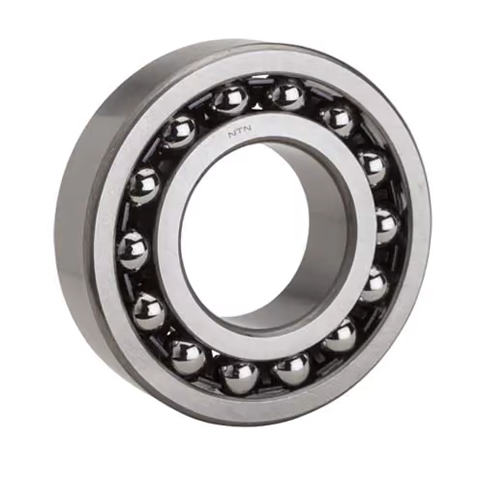
NTN NTN 1208K Self-Aligning Ball Bearing - Taper 1:12, 40 mm
NTN 1208K Self-Aligning Ball Bearing - Taper 1:12, 40 mm ID, 80 mm OD, 18 mm Width, Open, CN SPECIFICATIONS Bore Type Tapered Bore Diameter 1.5748 in, 40.000 mm Outside Diameter 3.1496 in, 80.000 mm Overall Width 18.000 mm, 0.7087 in Closure Type Open Cage Type Pressed Internal Clearance CN Operating Temperature Range -40 to 250 ºF Seal Material None Dynamic Load Capacity 4350 lbf Seal Type None Static Load Capacity 1460 lbf Precision Rating Class 0 Maximum RPM 9000 rpm Bearing Material High Carbon Chrome Steel Cage Material Steel Finish/Coating Uncoated Harmonization Code 8482.10.5060 Outer Ring Width 0.7087 in; 18.000 mm Inner Ring Width 18.000 mm, 0.7087 in Fillet Radius 1.100 mm, 0.0433 in Manufacturer UPC Number 4547359513271 Weight 0.899 lb 1. Design features and characteristics The outer ring raceway of self-aligning ball bearings forms a spherical surface whose center is common to the bearing center. The inner ring of the bearing has two raceways.The balls, cage, and inner ring of these bearings are capable of shifting in order to compensate for a certain degree of misalignment with the outer rings. As a result, the bearing is able to align itself and compensate for shaft / housing finishing unevenness, bearing fitting error, and other sources of misalignment as shown in Fig. 1.Since axial load capacity is limited, self- aligning ball bearing are not suitable for applications with heavy axial loads. It is recommended to use an adapter on a self-aligning ball bearing with a tapered bore inner diameter for ease of installation and disassembly. These bearings and adapters are often used on drive shaft applications. 2. Standard cage type All bearing series are equipped with a pressed cage, except 2321S and 2322S, which are equipped with a machined cage.Self-Aligning Ball BearingsIt is recommended to use an adapter on a self-aligning ball bearing with a tapered bore inner diameter for ease of installation and disassembly. These bearings and adapters are often used on drive shaft applications. Table 1 Standard cage types of spherical ball bearings 3. Ball protrusion Bearings with part numbers listed in Table 2 below have balls which protrude slightly from the bearing face as illustrated in Fig. 2. The total width dimensions are shown in Table 2. 4. Allowable misalignment angle The allowable misalignment angle can be determined by the following function. This degree of allowable misalignment may be limited by the design of mating components around the bearing.Normal load ....................... 1/15 5. Precautions for using self-aligning ball bearings Self-aligning ball bearings are unable to support large axial loads and therefore axial loading shall be limited.Please consider using self-aligning roller bearings when a large axial load is to be applied.
$17.19
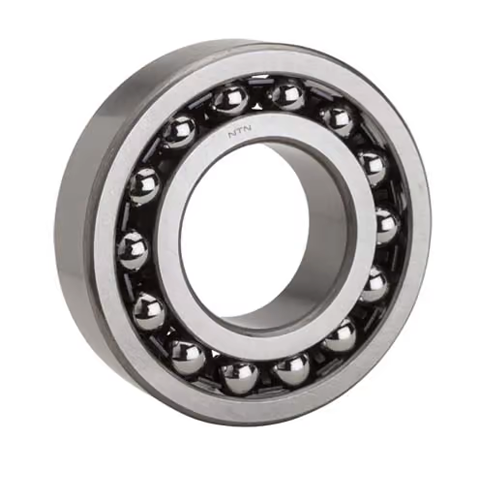
NTN NTN 1216 Self-Aligning Ball Bearing - Straight Bore, 80 mm ID, 140 mm OD, 26 mm Width, Open
NTN 1216 Self-Aligning Ball Bearing - Straight Bore, 80 mm ID, 140 mm OD, 26 mm Width, Open, CN SPECIFICATIONS Bore Type Cylindrical Bore Diameter 3.1496 in, 80.000 mm Outside Diameter 140.000 mm, 5.5118 in Overall Width 26.000 mm, 1.0236 in Closure Type Open Cage Type Pressed Internal Clearance CN Operating Temperature Range -40 to 250 ºF Seal Material None Dynamic Load Capacity 9000 lbf Seal Type None Static Load Capacity 3800 lbf Precision Rating Class 0 Maximum RPM 5000 rpm Bearing Material High Carbon Chrome Steel Cage Material Steel Finish/Coating Uncoated Harmonization Code 8482.10.5060 Outer Ring Width 1.0236 in; 26.000 mm Inner Ring Width 26.000 mm, 1.0236 in Fillet Radius 2.000 mm, 0.0787 in Manufacturer UPC Number 4547359255850 Weight 3.629 lb 1. Design features and characteristics The outer ring raceway of self-aligning ball bearings forms a spherical surface whose center is common to the bearing center. The inner ring of the bearing has two raceways.The balls, cage, and inner ring of these bearings are capable of shifting in order to compensate for a certain degree of misalignment with the outer rings. As a result, the bearing is able to align itself and compensate for shaft / housing finishing unevenness, bearing fitting error, and other sources of misalignment as shown in Fig. 1.Since axial load capacity is limited, self- aligning ball bearing are not suitable for applications with heavy axial loads. It is recommended to use an adapter on a self-aligning ball bearing with a tapered bore inner diameter for ease of installation and disassembly. These bearings and adapters are often used on drive shaft applications. 2. Standard cage type All bearing series are equipped with a pressed cage, except 2321S and 2322S, which are equipped with a machined cage.Self-Aligning Ball BearingsIt is recommended to use an adapter on a self-aligning ball bearing with a tapered bore inner diameter for ease of installation and disassembly. These bearings and adapters are often used on drive shaft applications. Table 1 Standard cage types of spherical ball bearings 3. Ball protrusion Bearings with part numbers listed in Table 2 below have balls which protrude slightly from the bearing face as illustrated in Fig. 2. The total width dimensions are shown in Table 2. 4. Allowable misalignment angle The allowable misalignment angle can be determined by the following function. This degree of allowable misalignment may be limited by the design of mating components around the bearing.Normal load ....................... 1/15 5. Precautions for using self-aligning ball bearings Self-aligning ball bearings are unable to support large axial loads and therefore axial loading shall be limited.Please consider using self-aligning roller bearings when a large axial load is to be applied.
$53.18
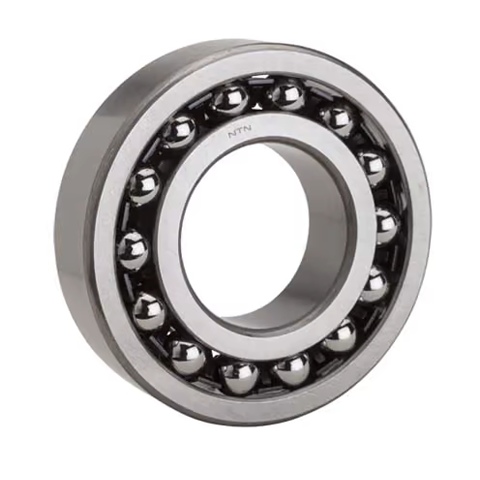
NTN NTN 1305K Self-Aligning Ball Bearing - 25 mm
NTN1305K Self Aligning Ball Bearings w/ Tapered Bore SPECIFICATIONS Bore Type Tapered Bore Diameter 25 mm, 0.9843 in Outside Diameter 62 mm, 2.4409 in Overall Width 17 mm, 0.6693 in Closure Type Open Cage Type Pressed Internal Clearance CN Operating Temperature Range -40 to 250 ºF Seal Material None Dynamic Load Capacity 4100 lbf Seal Type None Static Load Capacity 1120 lbf Precision Rating Class 0 Maximum RPM 13000 rpm Bearing Material High Carbon Chrome Steel Cage Material Steel Harmonization Code 8482.10.5060 Outer Ring Width 0.6693 in; 17.000 mm Inner Ring Width 17.000 mm, 0.6693 in Fillet Radius 1.100 mm, 0.0433 in Manufacturer UPC Number 4547359746303 Weight 0.553 lb 1. Design features and characteristics The outer ring raceway of self-aligning ball bearings forms a spherical surface whose center is common to the bearing center. The inner ring of the bearing has two raceways.The balls, cage, and inner ring of these bearings are capable of shifting in order to compensate for a certain degree of misalignment with the outer rings. As a result, the bearing is able to align itself and compensate for shaft / housing finishing unevenness, bearing fitting error, and other sources of misalignment as shown in Fig. 1.Since axial load capacity is limited, self- aligning ball bearing are not suitable for applications with heavy axial loads. It is recommended to use an adapter on a self-aligning ball bearing with a tapered bore inner diameter for ease of installation and disassembly. These bearings and adapters are often used on drive shaft applications. 2. Standard cage type All bearing series are equipped with a pressed cage, except 2321S and 2322S, which are equipped with a machined cage.Self-Aligning Ball BearingsIt is recommended to use an adapter on a self-aligning ball bearing with a tapered bore inner diameter for ease of installation and disassembly. These bearings and adapters are often used on drive shaft applications. Table 1 Standard cage types of spherical ball bearings 3. Ball protrusion Bearings with part numbers listed in Table 2 below have balls which protrude slightly from the bearing face as illustrated in Fig. 2. The total width dimensions are shown in Table 2. 4. Allowable misalignment angle The allowable misalignment angle can be determined by the following function. This degree of allowable misalignment may be limited by the design of mating components around the bearing.Normal load ....................... 1/15 5. Precautions for using self-aligning ball bearings Self-aligning ball bearings are unable to support large axial loads and therefore axial loading shall be limited.Please consider using self-aligning roller bearings when a large axial load is to be applied.
$13.40















































